Winter is here! Check out the winter wonderlands at these 5 amazing winter destinations in Montana
- Travel Tips

What Is Green Tourism
Published: December 12, 2023
Modified: December 28, 2023
by Nedi Breland
- Hotel Reviews
- Sustainability
Introduction
Welcome to the world of green tourism, where sustainable travel meets environmental responsibility. As the global awareness of climate change and ecological preservation continues to grow, so does the importance of adopting eco-friendly practices in the tourism industry. Green tourism, also known as sustainable tourism or eco-tourism, is a concept that focuses on promoting travel activities that have minimal impact on the environment, preserve local cultures, and provide social and economic benefits to the host communities.
Green tourism goes beyond simply visiting natural attractions or staying in eco-friendly accommodations. It encompasses a range of practices that prioritize sustainability, conservation, and respect for local communities. This type of tourism aims to strike a balance between experiencing the beauty of our planet and actively contributing to its protection.
In recent years, green tourism has gained significant momentum, with travelers becoming more conscious of their environmental footprint and seeking out destinations and experiences that align with their values. This shift in consumer behavior has prompted tour operators, hoteliers, and governments to embrace sustainable practices in their operations and make conscious efforts to reduce their carbon footprint.
Moreover, the concept of green tourism extends beyond environmental considerations. It also takes into account the social and economic impact of tourism on local communities. Green tourism initiatives often promote community involvement, fair employment practices, and the preservation of cultural heritage, ensuring that the benefits of tourism are shared with all stakeholders.
With the increasing popularity of green tourism, a range of certification programs and guidelines have been established to help travelers identify truly sustainable options. These certifications not only provide travelers with the reassurance that they are making responsible travel choices but also incentivize businesses to adopt environmentally friendly practices.
In this article, we will explore the various aspects of green tourism, including its definition, benefits, principles, and practices. We will also delve into the world of green tourism certification programs and examine real-life case studies showcasing successful implementations. Finally, we will discuss the challenges and opportunities that arise in the realm of green tourism.
So strap on your backpack and get ready to embark on a sustainable journey to explore the wonders of green tourism!
Definition of Green Tourism
Green tourism, also referred to as sustainable tourism or eco-tourism, is a form of travel that focuses on minimizing the negative impact on the environment, supporting local communities, and preserving cultural heritage. It aims to create a balance between enjoying the beauty of natural and cultural attractions while promoting responsible and sustainable practices.
At its core, green tourism revolves around three main pillars: environmental conservation, socio-cultural respect, and economic viability. These pillars guide travelers, tour operators, and destination managers in adopting sustainable practices that benefit both the environment and the communities they visit.
From an environmental perspective, green tourism places a strong emphasis on reducing carbon emissions, conserving natural resources, and protecting biodiversity. Travelers are encouraged to choose eco-friendly accommodations, participate in nature-based activities with minimal disturbance to ecosystems, and support businesses that implement sustainable waste management and energy conservation practices.
In terms of socio-cultural respect, green tourism promotes the preservation of local cultures, traditions, and ways of life. It encourages travelers to interact with local communities in a respectful manner, fostering cultural exchange and supporting the local economy through the purchase of locally made products and services. By doing so, green tourism helps preserve cultural diversity and heritage, ensuring that future generations can continue to appreciate and learn from them.
Lastly, economic viability is a crucial aspect of green tourism. It recognizes the importance of ensuring that tourism generates economic benefits for local communities rather than exploiting or displacing them. Green tourism initiatives aim to create opportunities for local employment, promote fair wages and working conditions, and encourage the reinvestment of tourism revenue back into the community for infrastructure development, education, and healthcare.
Overall, green tourism strives to create a sustainable travel experience for both travelers and host communities. It encourages responsible behavior, raises awareness about environmental and social issues, and fosters a sense of appreciation for the natural and cultural wonders of the world.
Benefits of Green Tourism
Green tourism offers a multitude of benefits, not only for travelers but also for the environment, local communities, and the tourism industry as a whole.
One of the primary benefits of green tourism is its positive impact on the environment. By promoting sustainable practices such as energy conservation, waste reduction, and the use of renewable resources, green tourism helps minimize the ecological footprint of travel activities. This leads to a reduced carbon footprint, decreased pollution, and the preservation of natural habitats and biodiversity.
Furthermore, green tourism encourages travelers to engage in nature-based activities that foster a deeper appreciation and understanding of the environment. This heightened appreciation can lead to increased support for conservation efforts and the protection of fragile ecosystems.
Green tourism also brings significant socio-cultural benefits. By promoting respect for local customs, traditions, and cultures, it helps preserve and celebrate cultural heritage. Travelers have the opportunity to immerse themselves in authentic cultural experiences, engage with local communities, and contribute to the economic growth of these communities through the purchase of locally made products and services.
Moreover, green tourism often leads to the creation of employment opportunities for local residents. By supporting small businesses, eco-lodges, and community-based tourism initiatives, green tourism generates income for local communities, empowering them economically and reducing dependence on external sources of income.
For travelers, green tourism offers a unique and meaningful travel experience. It allows them to connect with nature, gain a deeper understanding of local cultures, and make a positive impact on the destinations they visit. Green tourism provides opportunities for personal growth, self-reflection, and a sense of fulfillment that comes from traveling responsibly and sustainably.
From a business perspective, adopting green tourism practices can lead to a competitive advantage. By demonstrating a commitment to sustainability, businesses can attract environmentally conscious travelers who actively seek out eco-friendly options. Green tourism initiatives also often result in cost savings through energy efficiency measures, waste reduction, and operational optimization.
Overall, green tourism benefits not only the travelers but also the environment, local communities, and the tourism industry. It offers a more responsible and sustainable approach to travel, ensuring that future generations can continue to enjoy the wonders of our world.
Principles of Green Tourism
Green tourism is guided by a set of principles that help ensure sustainable and responsible practices in the industry. These principles serve as a framework for businesses, travelers, and destination managers to make informed decisions that prioritize environmental conservation, socio-cultural respect, and economic viability.
1. Environmental Conservation: The principle of environmental conservation focuses on minimizing the negative impact of tourism on natural resources and ecosystems. This includes reducing carbon emissions, conserving water and energy, protecting biodiversity, and promoting sustainable waste management practices. Businesses and travelers are encouraged to choose eco-friendly accommodations, engage in low-impact activities, and support initiatives that contribute to the preservation and restoration of the environment.
2. Socio-cultural Respect: Green tourism emphasizes the importance of respecting and celebrating local cultures, traditions, and ways of life. This principle encourages travelers to engage in meaningful interactions with local communities, learn about their customs and traditions, and contribute to the local economy through the support of locally owned businesses. It also emphasizes the preservation of cultural heritage and the promotion of fair and responsible tourism practices that benefit host communities.
3. Community Involvement: Green tourism recognizes the value of involving local communities in decision-making processes and ensuring that they benefit from tourism activities. This principle aims to empower local residents by creating opportunities for employment, supporting community-based tourism initiatives, and facilitating the equitable distribution of tourism revenue. It encourages social and economic development that is inclusive and sustainable.
4. Education and Awareness: Green tourism promotes education and awareness about sustainability issues among travelers, businesses, and local communities. This principle emphasizes the importance of educating travelers about responsible travel practices, environmental conservation, and cultural sensitivity. It encourages businesses to provide training and resources to employees, fostering a culture of sustainability throughout the tourism industry.
5. Collaboration and Partnerships: Green tourism recognizes that achieving sustainability goals requires collaboration and partnerships among various stakeholders. This principle encourages businesses, government agencies, NGOs, and local communities to work together in implementing sustainable tourism practices. Collaboration promotes knowledge sharing, resource pooling, and the development of innovative solutions that benefit both the environment and local communities.
6. Continuous Improvement: Green tourism embraces the principle of continuous improvement, acknowledging that sustainability is an ongoing process. Businesses and destinations are encouraged to regularly evaluate their practices, set goals for improvement, and measure their environmental and socio-cultural performance. By striving for continuous improvement, green tourism ensures that initiatives remain relevant, effective, and adaptable to changing circumstances and emerging sustainability challenges.
By adhering to these principles, green tourism aims to provide a framework for responsible and sustainable travel practices that not only benefit the environment but also contribute to the well-being and prosperity of local communities.
Green Tourism Practices
Green tourism involves a range of practices that prioritize sustainability, conservation, and responsible behavior. These practices span various aspects of travel, from transportation and accommodation to activities and interactions with local communities. Here are some key green tourism practices:
1. Sustainable Transportation: Traveling to and within destinations in a sustainable manner is an important aspect of green tourism. This includes opting for public transportation, cycling, or walking whenever possible, as well as choosing fuel-efficient vehicles or carpooling. Travelers can also offset their carbon emissions by supporting carbon offset programs.
2. Eco-friendly Accommodations: Green tourism encourages staying in eco-friendly accommodations that have implemented sustainable practices. Look for accommodations that have energy-efficient systems, water conservation measures, waste recycling programs, and use renewable energy sources. Eco-lodges, eco-resorts, and eco-hotels often prioritize sustainability and offer unique and authentic experiences.
3. Responsible Wildlife and Nature Experiences: Green tourism promotes responsible wildlife and nature experiences that prioritize the well-being and conservation of animals and ecosystems. Choose tour operators and activities that adhere to responsible wildlife viewing practices, such as maintaining a safe distance, avoiding interactions that disrupt natural behaviors, and supporting initiatives that contribute to conservation efforts.
4. Support Local Communities: Green tourism emphasizes supporting local communities by engaging in responsible and ethical tourism practices. This includes purchasing locally made products, participating in cultural activities and events, and patronizing local businesses and restaurants. By supporting the local economy, travelers can contribute to the socio-economic development of the community.
5. Minimize Waste: Green tourism encourages the reduction, reuse, and recycling of waste. Travelers are encouraged to bring reusable water bottles, utensils, and shopping bags to minimize single-use plastics. Using refill stations and recycling facilities provided by the accommodations and destinations is also important in minimizing waste generation.
6. Respect Local Culture and Customs: Green tourism promotes cultural sensitivity and respect for local culture and customs. Before visiting a destination, familiarize yourself with the local customs, traditions, and etiquette to ensure respectful interactions. Seek permission before taking photographs, refrain from inappropriate behavior, and support cultural preservation initiatives.
7. Responsible Water Usage: Water conservation is a critical aspect of green tourism. Travelers are encouraged to be conscious of their water consumption, limiting unnecessary water use such as taking shorter showers, reusing towels, and reporting any leaks or water wastage to the accommodation staff. Additionally, supporting initiatives that promote access to clean water for local communities is crucial.
These are just a few examples of the green tourism practices that travelers can adopt to minimize their environmental impact and contribute positively to the destinations they visit. By being mindful of these practices, travelers can play an active role in promoting sustainability and conservation in the tourism industry.
Green Tourism Certification Programs
To help travelers identify truly sustainable and responsible travel options, various green tourism certification programs have been established around the world. These certification programs assess and recognize businesses that meet specific criteria and standards related to environmentally and socially responsible practices. Here are a few notable green tourism certification programs:
1. Green Globe: Green Globe is a leading sustainability certification program for the travel and tourism industry. It provides certification to businesses that meet strict criteria in areas such as environmental management, social responsibility, cultural heritage protection, and economic benefits to local communities. Green Globe-certified businesses are committed to sustainable practices across their operations.
2. Rainforest Alliance: The Rainforest Alliance certification program focuses on promoting sustainable practices in agriculture, forestry, and tourism. Their certification ensures that businesses adhere to environmental and social standards that protect ecosystems, conserve natural resources, and promote the well-being of local communities. Rainforest Alliance-certified accommodations, tour operators, and attractions contribute to the conservation of biodiversity and the fight against climate change.
3. LEED Certification: LEED (Leadership in Energy and Environmental Design) is a globally recognized green building certification program. While it primarily focuses on building design and construction, LEED certification is also applicable to hotels and accommodations that meet specific sustainability and energy efficiency standards. LEED-certified properties prioritize resource conservation, waste reduction, and indoor environmental quality.
4. EarthCheck: EarthCheck is a certification program that assesses the environmental and social sustainability performance of tourism operators and destinations. It provides businesses with feedback and guidance on ways to improve their sustainability practices. EarthCheck-certified businesses undergo regular audits to ensure ongoing compliance with internationally recognized standards in areas such as waste management, energy efficiency, and community engagement.
5. Travelife: Travelife is an internationally recognized certification program for tour operators, travel agencies, and accommodations. It assesses the sustainability performance of businesses based on a comprehensive set of criteria, covering environmental, social, and economic aspects. Travelife-certified businesses are committed to reducing their environmental footprint and contributing to the welfare of local communities through responsible practices and initiatives.
These are just a few examples of the many green tourism certification programs available worldwide. By seeking out and supporting businesses with these certifications, travelers can have confidence in the sustainability and responsible practices of the establishments they choose to visit. These certifications also incentivize businesses to continually improve and uphold environmentally and socially sustainable practices within the tourism industry.
Case Studies of Green Tourism Success
Several destinations and businesses have successfully implemented green tourism practices, showcasing the positive impact that sustainability can have on both the environment and local communities. Here are a few inspiring case studies:
1. Costa Rica: Costa Rica has long been regarded as a leader in green tourism. The country has made significant strides in the conservation of its rich biodiversity and natural resources. Costa Rica implemented a payment for environmental services program that incentivizes landowners to protect and preserve forests. It also promotes sustainable agriculture, renewable energy, and eco-tourism initiatives. This dedication to sustainability has positioned Costa Rica as a top destination for eco-conscious travelers, contributing to the country’s economic growth and environmental preservation.
2. Soneva Resorts, Maldives: Soneva Resorts is a group of luxury resorts in the Maldives that has pioneered sustainable tourism practices. They prioritize waste reduction and have implemented initiatives such as on-site composting, water filtration and bottling plants, and a carbon offset program. Soneva Resorts also actively engages with local communities, providing employment opportunities and supporting education and healthcare initiatives. These efforts have not only minimized the environmental impact of their operations but have also positively impacted the well-being of local communities.
3. Grootbos Private Nature Reserve, South Africa: Grootbos Private Nature Reserve is an award-winning eco-lodge in South Africa. It focuses on conservation, sustainable land management, and community empowerment. The reserve offers guided tours that educate visitors about local flora and fauna, reforestation projects, and community development initiatives. Grootbos also supports local schools, provides training for community members, and contributes to the preservation of the unique Fynbos biome. Its commitment to environmental and social sustainability has made it a role model for responsible tourism in the region.
4. Glacier National Park, USA: Glacier National Park in Montana, USA, has implemented a range of sustainable practices to mitigate the effects of climate change and protect its pristine wilderness. The park encourages eco-friendly transportation by providing shuttle services and promoting cycling and hiking trails. It also focuses on waste reduction and recycling, energy efficiency, and the preservation of wildlife habitats. Glacier National Park serves as both a natural haven for visitors and an example of how protected areas can actively combat environmental challenges.
These case studies highlight the positive outcomes that can be achieved through the implementation of green tourism practices. From the conservation of natural resources to the support of local communities, these examples demonstrate the potential for sustainability to thrive within the tourism industry. By learning from these success stories, other destinations and businesses can be inspired to adopt and prioritize green tourism practices.
Challenges and Opportunities in Green Tourism
While green tourism brings numerous benefits, it also faces challenges that need to be addressed for the industry to continue its sustainable growth. At the same time, these challenges present opportunities for innovation and improvement. Here are some key challenges and opportunities in green tourism:
1. Awareness and Education: One of the main challenges in green tourism is the lack of awareness and understanding among both travelers and businesses. Many people are still unfamiliar with sustainable travel practices or the importance of choosing eco-friendly options. The opportunity lies in education and raising awareness about the benefits of green tourism. By providing information and promoting sustainable practices, the tourism industry can empower travelers to make more responsible choices.
2. Infrastructure and Technology: The availability of sustainable infrastructure and technologies is crucial for the growth of green tourism. However, implementing green infrastructure and adopting sustainable technologies can be challenging, particularly for smaller businesses and destinations. The opportunity lies in investing in renewable energy, efficient waste management systems, and eco-friendly transportation options. Collaboration between governments, businesses, and technology providers can help overcome these challenges and create more sustainable tourism infrastructures.
3. Balancing Conservation and Tourism: Sustainable tourism must strike a balance between meeting the needs of tourists and conserving natural and cultural assets. Managing visitor numbers, preserving delicate ecosystems, and mitigating the impact of tourism activities on local communities can be challenging. The opportunity lies in implementing responsible tourism practices, setting carrying capacity limits, and involving local communities in decision-making processes. By managing tourism sustainably, destinations can protect their unique assets while ensuring a positive and authentic travel experience.
4. Economic Viability: Green tourism initiatives can require upfront investments and may have higher operating costs compared to conventional practices. This can pose a challenge to businesses, particularly small and medium enterprises. However, green tourism also presents opportunities for new revenue streams and niche markets. Sustainable tourism practices can attract environmentally conscious travelers who are willing to pay a premium for a responsible travel experience. By focusing on innovative business models and promoting sustainability as a marketing asset, businesses can tap into the growing market of eco-conscious travelers.
5. Collaboration and Partnerships: Collaboration between various stakeholders, including governments, businesses, local communities, and non-governmental organizations, is essential for the success of green tourism. However, building strong partnerships can be challenging due to diverse interests, limited resources, and differing priorities. The opportunity lies in fostering collaboration and establishing platforms for dialogue and knowledge sharing. By working together, stakeholders can address common challenges, share best practices, and develop sustainable tourism strategies that benefit all parties involved.
By acknowledging and addressing these challenges, the tourism industry can embrace the opportunities presented by green tourism. Collaboration, innovation, education, and responsible practices are key to overcoming hurdles and creating a sustainable future for the industry.
Green tourism offers a transformative approach to travel, emphasizing sustainability, conservation, and responsible practices. It has the power to not only protect the environment and preserve cultural heritage but also bring economic benefits to local communities. By adopting green tourism practices, travelers can contribute to the well-being of the planet and make a positive impact on the destinations they visit.
Throughout this article, we have explored the definition of green tourism and its core principles. We have delved into the benefits of green tourism, including environmental conservation, socio-cultural respect, and economic viability. We have also examined various green tourism practices, such as sustainable transportation, eco-friendly accommodations, and responsible wildlife experiences.
Moreover, we have highlighted the importance of green tourism certification programs, which help travelers identify businesses committed to sustainable practices. We have provided case studies showcasing successful implementation of green tourism initiatives, as well as discussed the challenges and opportunities faced by the industry.
As we conclude, it is clear that green tourism is more than a trend; it is a necessary shift towards a more sustainable and responsible travel industry. The power to make a difference lies in the hands of individual travelers, businesses, and governments. By making conscious choices, supporting sustainable initiatives, and advocating for change, we can ensure the preservation of our planet’s natural and cultural treasures for future generations.
So, let us embark on our travel journeys with the principles of green tourism in mind. Let us strive to minimize our environmental footprint, respect local cultures, and support the well-being of host communities. Together, we can create a world where travel not only enriches our lives but also protects the world we call home.

- Privacy Overview
- Strictly Necessary Cookies
This website uses cookies so that we can provide you with the best user experience possible. Cookie information is stored in your browser and performs functions such as recognising you when you return to our website and helping our team to understand which sections of the website you find most interesting and useful.
Strictly Necessary Cookie should be enabled at all times so that we can save your preferences for cookie settings.
If you disable this cookie, we will not be able to save your preferences. This means that every time you visit this website you will need to enable or disable cookies again.
- Privacy & Disclaimer
Living There

Green Tourism: Embracing Sustainable Travel Practices
The essential guide to green tourism: how to travel sustainably.
Green tourism, also known as sustainable tourism, has become an increasingly popular way to travel. It aims to minimize the negative impacts of traditional tourism on communities and the environment. With more travelers looking for eco-friendly lodging, transportation and activities, green tourism offers a way to explore new places while also supporting local cultures and conservation efforts. This guide will provide tips and resources for planning a sustainable trip from start to finish.
What is Green Tourism?
Green tourism prioritizes environmental sustainability, social responsibility and economic benefits for local communities. According to the U.N. Environment Programme, green tourism involves “making better choices that minimize environmental impact, provide memorable experiences for visitors and offer socio-economic benefits to local people.”
Some key principles of green tourism include:
- Minimizing environmental impact by reducing energy and water consumption, waste, pollution and harm to ecosystems.
- Supporting local economies by choosing locally-owned hotels, tour operators and businesses.
- Learning about local cultures, customs and environments to foster deeper connections.
- Traveling responsibly by being respectful of communities visited and following ethical guidelines.
- Eco-conscious transportation choices like public transit, walking, biking or electric/hybrid vehicles.
The green tourism movement emerged in the 1980s as travelers became more aware of the potential negative impacts of mainstream tourism. Activists called for practices that could balance tourism growth with conservation and community development.
Since then, global initiatives like eco-certification programs and awards for sustainable tourism providers have helped green tourism expand. Major travel companies now offer eco-friendly tours and carbon offset options. With climate change and overtourism challenges, green principles are vital for tourism’s future.
Green Tourism Eco-Friendly Transportation Options
Getting to your destination is an important part of any trip. As a green traveler, consider lower-impact transit choices that reduce carbon emissions:
Public Transportation
Buses, trains, metros and other public transit are more sustainable options than driving. Look for routes that connect to your destination directly or indirectly. For longer journeys, opt for a night train or bus to save on accommodation too.
Walking and Biking Green Tourism
Active transport like walking and biking liberates you to explore up close while avoiding emissions. Urban areas are often best discovered on foot or bike. Ask your hotel about rentals or city bike share programs.
Ride Sharing
Carpooling via services like BlaBlaCar cuts fuel use by sharing rides. Apps like these connect travelers headed the same way. Some local ride sharing services cater specifically to tourists.
Electric and Hybrid Vehicles
If renting a car, choose electric or hybrid models which release fewer emissions. Hertz, Enterprise, Sixt and other rental companies offer these greener options in many locations.
Carbon Offsets Green Tourism
Offset the emissions of your trip by investing in environmental projects that reduce CO2. Trusted offset providers include Cool Effect and Terrapass. Calculate your footprint and donate to renewable energy or tree planting efforts.
Green Accommodation Options
Where you stay makes a difference. Research lodging with eco-friendly practices like:
Purpose-built ecolodges focus on sustainability through renewable energy, water conservation, waste management and environmentally sensitive design. Many are located in natural settings with minimal footprints. For example, Inkaterra Reserva Amazonica in Peru showcases its eco-lodge model.
Green Hotels
Look for hotels with environmental certifications like Green Key or sustainability programs. Policies may include renewable energy sources, efficient lighting, linen/towel reuse options and recycling. Hotels committed to green principles include Six Senses, 1 Hotels and Proximity Hotel.
Homestays and B&Bs
Local small accommodation provides cultural immersion and keeps money in the community. Search sites like Airbnb for eco-friendly homes and properties. Seek options with environmental designs.
Green Tourism Camping
Get closer to nature by camping on public lands, private eco-campgrounds or glamping resorts. Follow Leave No Trace principles when camping in sensitive natural areas. Companies like Collective Retreats offer luxury camping with a focus on sustainability.
No matter the lodging type, look for renewable energy usage, water conservation like low-flow fixtures, effective waste and recycling programs, locally sourced foods and supplies, and sensitivity to surrounding environments.
Top Destinations for Green Travelers
Here are some of the world’s best places to experience green tourism first-hand:
With lush rainforests, beaches and volcanoes, Costa Rica attracts eco-minded visitors to its protected lands. National parks like Manuel Antonio safeguard diverse wildlife. Hotels, tour operators and communities actively engage in sustainability. Popular activities include jungle hikes, rafting, surfing and wildlife viewing.
This Pacific island nation offers pristine coral reefs ideal for snorkeling and scuba diving. Palau conserves marine biodiversity in protected waters and sanctuaries. Eco-resorts, sustainable diving operations and education efforts have made Palau a prime green destination.
Slovenia holds the title of first Green Globe destination in the world for its commitment to sustainable tourism. Stunning Alpine scenery, expansive forests and charming towns make it a nature lover’s haven. Slovenia’s extensive hiking and biking trails showcase the outdoors.
SwedenGreen Tourism
Sweden actively pursues eco-friendly practices from transportation to hotels. Stockholm was named Europe’s first European Green Capital for its sustainability efforts. Sweden also excels at eco-tourism focused on small footprint activities like wildlife viewing, sailing, biking, hiking and camping.
Kerala, India
The beaches, backwaters and tea plantations of Kerala invite green travelers. Visitors can stay on eco-friendly houseboats, get around by bike or canoe, and tour sustainably managed spice gardens and tea estates. Kerala’s emphasis on environmental protection and social wellbeing align with green tourism goals.
Torres del Paine, Chile
From azure lakes to soaring Andean peaks, Chile’s Torres del Paine National Park is regarded as one of the most stunning natural sites in the world. Strict visitor regulations help conserve its beauty. Patagonia’s cutting edge eco-lodges, hiking trails and preservation efforts further boost sustainable travel here.
These destinations and many more demonstrate how green tourism positively impacts communities, preserves cultures and protects fragile ecosystems so they may be enjoyed responsibly.
Making Green Choices as an Eco-Friendly Traveler
Travelers have significant power to minimize their environmental impact through conscientious choices:
Pack Light and Avoid Single-Use Plastics
Pack only essentials to reduce weight and avoid disposable plastics that end up as waste. Bring reusable bags, bottles, straws and utensils for the journey. Say no to room products in plastic containers.
Choose Responsible Tour Providers
Select operators committed to sustainability like G Adventures which supports local businesses. Seek companies certified by organizations like Travelife that audit environmental, social and economic practices.
Green Tourism Conserve Resources
Lessen your consumption of energy and water during your stay by turning off lights, reusing towels and taking shorter showers. Dispose of waste properly and use recycling bins.
Support Local Businesses Green Tourism
Eat, shop and experience activities at locally-owned establishments so money stays in the community. Avoid international chains which send profits abroad. Seek authentic cultural experiences.
Volunteer Thoughtfully
If volunteering, scrutinize programs for ethical, long-term impact. Focus on community-driven initiatives rather than short-term missions. Skilled contributions are most valuable.
Green Tourism Follow Guidelines
Adhere to rules and guidelines to minimize your impact like staying on trails, not feeding wildlife and avoiding banned activities that disrupt natural habitats.
Travelers should be mindful of their choices before and during trips to ensure the principles of green tourism are upheld.
The Future of Sustainable Travel Green Tourism
The trajectory of green tourism points towards further growth as climate change pressures the industry to adopt more sustainable models. Travelers increasingly demand eco-friendly options while governments implement environmental regulations.
New technologies will continue improving energy and water efficiency. Renewable energy systems are becoming more affordable and widespread. Creative conservation financing like credits and offsets will likely expand to engage travelers directly in funding green projects.
Yet challenges remain in fully mainstreaming sustainable practices. Achieving climate neutral travel will necessitate improvements across massive transportation networks and energy grids. Overtourism strains popular destinations and requires visitor management strategies.
Travelers will play a key role by supporting businesses pursuing sustainability, offsetting emissions and voting with their travel dollars to propel green tourism. Avoiding overtouristed destinations in favor of less crowded ethical alternatives makes a difference.
With mindful choices, travelers can protect the planet and communities they visit for generations to come. Green tourism provides a meaningful way to cultivate care for nature and culture while exploring the diversity of our world.
Conclusion of Green Tourism
Green tourism offers endless opportunities to tread lightly, engage local communities and appreciate nature’s gifts more deeply. This guide outlines principles, transportation modes, eco accommodation, destinations and traveler tips to enhance sustainability.
Making mindful choices throughout the journey – from transit to activities – enables travelers to curtail their environmental impact. Selecting tour providers vetted for ethical practices ensures money spent gives back. Discovering destinations’ natural and cultural richness through an eco-friendly lens fosters wonder and care for our shared planet.
Travel is a transformative portal. The green tourism movement opens the doorway to next generation travel defined by environmental values, social consciousness and a restored balance with the natural world. By supporting sustainable models, travelers become active stewards preserving our living planet for the future.
FAQs about Green Tourism:
- What exactly is green tourism? Green tourism, also known as sustainable tourism, involves traveling responsibly to natural areas while conserving the environment and improving the well-being of local communities.
- How can I participate in green tourism? Transitioning from traditional travel practices to green tourism involves making conscious choices such as supporting eco-friendly accommodations, minimizing waste, and respecting local cultures and traditions.
- What are the benefits of green tourism? Green tourism promotes environmental conservation, fosters cultural exchange, supports local economies, and provides travelers with meaningful and authentic experiences.
- Are there any certifications or labels for tourism destinations? Yes, various organizations offer certifications and labels to identify destinations and accommodations that adhere to sustainable tourism practices. Look for certifications like Green Key, EarthCheck, or LEED certification for eco-friendly buildings.
- How can I find tourism destinations to visit? Research online resources, consult with travel agencies specializing in sustainable travel, and look for recommendations from eco-conscious travelers to discover green tourism destinations around the world.
Reference Links:
http://medium.com/@fronnolluneiwa3418/ace-your-salesforce-b2c-commerce-developer-exam-with-official-exam-dumpss-comprehensive-dumps-pdf-4a312becbbb0
http://medium.com/@fronnolluneiwa3418/ace-your-oracle-1z0-083-exam-with-official-exam-dumps-authentic-practice-questions-e0867b640f4a
http://medium.com/@fronnolluneiwa3418/unlock-your-salesforce-pardot-consultant-certification-with-official-exam-dumps-1d5d1c2f2f4b
http://medium.com/@fronnolluneiwa3418/unlock-your-cisco-350-801-success-with-official-exam-dumpss-comprehensive-dumps-2e40a12d18e8
http://medium.com/@fronnolluneiwa3418/unlock-your-aws-dbs-c01-certification-success-with-official-exam-dumpss-reliable-dumps-ac80ddc3241e

About M Williams
Related Posts

Yttowav: Exploring Nature’s Serenity and Beauty
March 9, 2024

Belize City Tourism: Exploring Caribbean Charm and Culture

Axiom Telecom LLC: Trusted Telecommunication Solutions Provider
March 8, 2024
Sustainable tourism
Related sdgs, promote sustained, inclusive and sustainable ....

Description
Publications.
Tourism is one of the world's fastest growing industries and an important source of foreign exchange and employment, while being closely linked to the social, economic, and environmental well-being of many countries, especially developing countries. Maritime or ocean-related tourism, as well as coastal tourism, are for example vital sectors of the economy in small island developing States (SIDS) and coastal least developed countries (LDCs) (see also: The Potential of the Blue Economy report as well as the Community of Ocean Action on sustainable blue economy).
The World Tourism Organization defines sustainable tourism as “tourism that takes full account of its current and future economic, social and environmental impacts, addressing the needs of visitors, the industry, the environment and host communities".
Based on General assembly resolution 70/193, 2017 was declared as the International Year of Sustainable Tourism for Development.
In the 2030 Agenda for Sustainable Development SDG target 8.9, aims to “by 2030, devise and implement policies to promote sustainable tourism that creates jobs and promotes local culture and products”. The importance of sustainable tourism is also highlighted in SDG target 12.b. which aims to “develop and implement tools to monitor sustainable development impacts for sustainable tourism that creates jobs and promotes local culture and products”.
Tourism is also identified as one of the tools to “by 2030, increase the economic benefits to Small Island developing States and least developed countries” as comprised in SDG target 14.7.
In the Rio+20 outcome document The Future We want, sustainable tourism is defined by paragraph 130 as a significant contributor “to the three dimensions of sustainable development” thanks to its close linkages to other sectors and its ability to create decent jobs and generate trade opportunities. Therefore, Member States recognize “the need to support sustainable tourism activities and relevant capacity-building that promote environmental awareness, conserve and protect the environment, respect wildlife, flora, biodiversity, ecosystems and cultural diversity, and improve the welfare and livelihoods of local communities by supporting their local economies and the human and natural environment as a whole. ” In paragraph 130, Member States also “call for enhanced support for sustainable tourism activities and relevant capacity-building in developing countries in order to contribute to the achievement of sustainable development”.
In paragraph 131, Member States “encourage the promotion of investment in sustainable tourism, including eco-tourism and cultural tourism, which may include creating small- and medium-sized enterprises and facilitating access to finance, including through microcredit initiatives for the poor, indigenous peoples and local communities in areas with high eco-tourism potential”. In this regard, Member States also “underline the importance of establishing, where necessary, appropriate guidelines and regulations in accordance with national priorities and legislation for promoting and supporting sustainable tourism”.
In 2002, the World Summit on Sustainable Development in Johannesburg called for the promotion of sustainable tourism development, including non-consumptive and eco-tourism, in Chapter IV, paragraph 43 of the Johannesburg Plan of Implementation.
At the Johannesburg Summit, the launch of the “Sustainable Tourism – Eliminating Poverty (ST-EP) initiative was announced. The initiative was inaugurated by the World Tourism Organization, in collaboration with UNCTAD, in order to develop sustainable tourism as a force for poverty alleviation.
The UN Commission on Sustainable Development (CSD) last reviewed the issue of sustainable tourism in 2001, when it was acting as the Preparatory Committee for the Johannesburg Summit.
The importance of sustainable tourism was also mentioned in Agenda 21.
For more information and documents on this topic, please visit this link
UNWTO Annual Report 2015
2015 was a landmark year for the global community. In September, the 70th Session of the United Nations General Assembly adopted the Sustainable Development Goals (SDGs), a universal agenda for planet and people. Among the 17 SDGs and 169 associated targets, tourism is explicitly featured in Goa...
UNWTO Annual Report 2016
In December 2015, the United Nations General Assembly declared 2017 as the International Year of Sustainable Tourism for Development. This is a unique opportunity to devote a year to activities that promote the transformational power of tourism to help us reach a better future. This important cele...
Emerging Issues for Small Island Developing States
The 2012 UNEP Foresight Process on Emerging Global Environmental Issues primarily identified emerging environmental issues and possible solutions on a global scale and perspective. In 2013, UNEP carried out a similar exercise to identify priority emerging environmental issues that are of concern to ...
Transforming our World: The 2030 Agenda for Sustainable Development
This Agenda is a plan of action for people, planet and prosperity. It also seeks to strengthen universal peace in larger freedom, We recognize that eradicating poverty in all its forms and dimensions, including extreme poverty, is the greatest global challenge and an indispensable requirement for su...
15 Years of the UNWTO World Tourism Network on Child Protection: A Compilation of Good Practices
Although it is widely recognized that tourism is not the cause of child exploitation, it can aggravate the problem when parts of its infrastructure, such as transport networks and accommodation facilities, are exploited by child abusers for nefarious ends. Additionally, many other factors that contr...
Towards Measuring the Economic Value of Wildlife Watching Tourism in Africa
Set against the backdrop of the ongoing poaching crisis driven by a dramatic increase in the illicit trade in wildlife products, this briefing paper intends to support the ongoing efforts of African governments and the broader international community in the fight against poaching. Specifically, this...
Status and Trends of Caribbean Coral Reefs: 1970-2012
Previous Caribbean assessments lumped data together into a single database regardless of geographic location, reef environment, depth, oceanographic conditions, etc. Data from shallow lagoons and back reef environments were combined with data from deep fore-reef environments and atolls. Geographic c...
Natural Resources Forum: Special Issue Tourism
The journal considers papers on all topics relevant to sustainable development. In addition, it dedicates series, issues and special sections to specific themes that are relevant to the current discussions of the United Nations Commission on Sustainable Development (CSD)....
Thailand: Supporting Sustainable Development in Thailand: A Geographic Clusters Approach
Market forces and government policies, including the Tenth National Development Plan (2007-2012), are moving Thailand toward a more geographically specialized economy. There is a growing consensus that Thailand’s comparative and competitive advantages lie in amenity services that have high reliance...
Road Map on Building a Green Economy for Sustainable Development in Carriacou and Petite Martinique, Grenada
This publication is the product of an international study led by the Division for Sustainable Development (DSD) of the United Nations Department of Economic and Social Affairs (UNDESA) in cooperation with the Ministry of Carriacou and Petite Martinique Affairs and the Ministry of Environment, Foreig...
Natural Resources Forum, a United Nations Sustainable Development Journal (NRF)
Natural Resources Forum, a United Nations Sustainable Development Journal, seeks to address gaps in current knowledge and stimulate relevant policy discussions, leading to the implementation of the sustainable development agenda and the achievement of the Sustainable...
UN Ocean Conference 2025
Our Ocean, Our Future, Our Responsibility “The ocean is fundamental to life on our planet and to our future. The ocean is an important source of the planet’s biodiversity and plays a vital role in the climate system and water cycle. The ocean provides a range of ecosystem services, supplies us with
UN Ocean Conference 2022
The UN Ocean Conference 2022, co-hosted by the Governments of Kenya and Portugal, came at a critical time as the world was strengthening its efforts to mobilize, create and drive solutions to realize the 17 Sustainable Development Goals by 2030.
58th Session of the Commission for Social Development – CSocD58
22nd general assembly of the united nations world tourism organization, world tourism day 2017 official celebration.
This year’s World Tourism Day, held on 27 September, will be focused on Sustainable Tourism – a Tool for Development. Celebrated in line with the 2017 International Year of Sustainable Tourism for Development, the Day will be dedicated to exploring the contribution of tourism to the Sustainable Deve
World Tourism Day 2016 Official Celebration
Accessible Tourism for all is about the creation of environments that can cater for the needs of all of us, whether we are traveling or staying at home. May that be due to a disability, even temporary, families with small children, or the ageing population, at some point in our lives, sooner or late
4th Global Summit on City Tourism
The World Tourism Organisation (UNWTO) and the Regional Council for Tourism of Marrakesh with support of the Government of Morroco are organizing the 4th Global Summit on City Tourism in Marrakesh, Morroco (9-10 December 2015). International experts in city tourism, representatives of city DMOs, of
2nd Euro-Asian Mountain Resorts Conference
The World Tourism Organisation (UNWTO) and Ulsan Metropolitan City with support of the Government of the Republic of Korea are organizing the 2nd Euro-Asian Mountain Resorts Conference, in Ulsan, Republic of Korea (14 - 16 October 2015). Under the title “Paving the Way for a Bright Future for Mounta
21st General Assembly of the United Nations World Tourism Organization
Unwto regional conference enhancing brand africa - fostering tourism development.
Tourism is one of the Africa’s most promising sectors in terms of development, and represents a major opportunity to foster inclusive development, increase the region’s participation in the global economy and generate revenues for investment in other activities, including environmental preservation.
- January 2017 International Year of Tourism In the context of the universal 2030 Agenda for Sustainable Development and the Sustainable Development Goals (SDGs), the International Year aims to support a change in policies, business practices and consumer behavior towards a more sustainable tourism sector that can contribute to the SDGs.
- January 2015 Targets 8.9, 12 b,14.7 The 2030 Agenda for Sustainable Development commits Member States, through Sustainable Development Goal Target 8.9 to “devise and implement policies to promote sustainable tourism that creates jobs and promotes local culture and products”. The importance of sustainable tourism, as a driver for jobs creation and the promotion of local culture and products, is also highlighted in Sustainable Development Goal target 12.b. Tourism is also identified as one of the tools to “increase [by 2030] the economic benefits to Small Island developing States and least developed countries”, through Sustainable Development Goals Target 14.7.
- January 2012 Future We Want (Para 130-131) Sustainable tourism is defined as a significant contributor “to the three dimensions of sustainable development” thanks to its close linkages to other sectors and its ability to create decent jobs and generate trade opportunities. Therefore, Member States recognize “the need to support sustainable tourism activities and relevant capacity-building that promote environmental awareness, conserve and protect the environment, respect wildlife, flora, biodiversity, ecosystems and cultural diversity, and improve the welfare and livelihoods of local communities” as well as to “encourage the promotion of investment in sustainable tourism, including eco-tourism and cultural tourism, which may include creating small and medium sized enterprises and facilitating access to finance, including through microcredit initiatives for the poor, indigenous peoples and local communities in areas with high eco-tourism potential”.
- January 2009 Roadmap for Recovery UNWTO announced in March 2009 the elaboration of a Roadmap for Recovery to be finalized by UNWTO’s General Assembly, based on seven action points. The Roadmap includes a set of 15 recommendations based on three interlocking action areas: resilience, stimulus, green economy aimed at supporting the tourism sector and the global economy.
- January 2008 Global Sustainable Tourism Criteria The Global Sustainable Tourism Criteria represent the minimum requirements any tourism business should observe in order to ensure preservation and respect of the natural and cultural resources and make sure at the same time that tourism potential as tool for poverty alleviation is enforced. The Criteria are 41 and distributed into four different categories: 1) sustainability management, 2) social and economic 3) cultural 4) environmental.
- January 2003 WTO becomes a UN specialized body By Resolution 453 (XV), the Assembly agreed on the transformation of the WTO into a United Nations specialized body. Such transformation was later ratified by the United Nations General Assembly with the adoption of Resolution A/RES/58/232.
- January 2003 1st Int. Conf. on Climate Change and Tourism The conference was organized in order to gather tourism authorities, organizations, businesses and scientists to discuss on the impact that climate change can have on the tourist sector. The event took place from 9 till 11 April 2003 in Djerba, Tunisia.
- January 2002 World Ecotourism Summit Held in May 2002, in Quebec City, Canada, the Summit represented the most important event in the framework of the International Year of Ecosystem. The Summit identified as main themes: ecotourism policy and planning, regulation of ecotourism, product development, marketing and promotion of ecotourism and monitoring costs and benefits of ecotourism.
- January 1985 Tourism Bill of Rights and Tourist Code At the World Tourism Organization Sixth Assembly held in Sofia in 1985, the Tourism Bill of Rights and Tourist Code were adopted, setting out the rights and duties of tourists and host populations and formulating policies and action for implementation by states and the tourist industry.
- January 1982 Acapulco Document Adopted in 1982, the Acapulco Document acknowledges the new dimension and role of tourism as a positive instrument towards the improvement of the quality of life for all peoples, as well as a significant force for peace and international understanding. The Acapulco Document also urges Member States to elaborate their policies, plans and programmes on tourism, in accordance with their national priorities and within the framework of the programme of work of the World Tourism Organization.
Green tourism what it is and why it is so important

What is green tourism? Why is it so important? Which are the key benefits of this type of tourism?
In an age where the impact of tourism is becoming visibly apparent, green tourism becomes extremely important.
Read on to find out more.

Definition and origins
Green tourism stands for small-scale tourism which involves visiting natural areas while minimising environmental impacts. In a nutshell, this type of tourism tries to both minimise and reverse the negative effects of travel. These include: overcrowding, the destruction of heritage and the environment, globalisation, detrimental social change and many others.
Thankfully, more and more tourism destinations and enterprises are focusing on becoming more sustainable and encouraging responsible tourism.
Green tourism has been used interchangeably with such concepts as ecotourism, nature tourism, responsible tourism and rural tourism. Moreover, international organizations have defined the notion in line with the concept of sustainable tourism, which also considers other dimensions than environmental protection.

Main benefits of green tourism
But why should you try to engage in green tourism? Besides the fact that your actions will be contributing positively, there are some great benefits of sustainable tourism.
Firstly, green tourism supports local communities . Particularly, responsible tourism generates greater economic benefits for local people and enhances the well-being of host communities, improves working conditions and access to the industry.
Secondly, sustainable tourism has a lower ecological impact. On the one hand, part of green tourism is eating local produce and food from local businesses. On the other, importing food comes at a huge cost – economically and environmentally. By eating locally, you not only save many emissions but you will also find that the food is better. In particular, the ingredients are fresher, the locals know how to prepare them, and you will probably get to taste something brand new that will intrigue you.
Thirdly, green tourism provides more enjoyable experiences for tourists through more meaningful connections with local people, and a greater understanding of local cultural, social and environmental issues.
Other benefits of green tourism
Additionally, responsible tourism helps travellers become conscious of their choices . If you aspire to be a sustainable tourist, you should educate yourself before you go on your vacation.

Are there certain locations that you should not visit if you want to keep them sustainable? What carbon footprint do you leave behind? A responsible tourist will make decisions based on what is best for the local communities in the long term, making sure that the actions based on those decisions have a positive impact on those communities.
Finally, it is a way to open our minds to the world and the realisation that we are all different but we are also the same. And doing it responsibly gives us an opportunity to learn through meaningful connections with local people and to get a better understanding of local cultural, as well as social and environmental issues.

To sum up, travelling responsibly doesn’t only have a positive impact in the destinations and communities we visit, but it also provides us with enriching experiences that often stay with us and become the highlight in our memories.
And if you are looking for beautiful accommodation for your green travel vacation, check out our beautiful hotels .
Share This Story, Choose Your Platform!
Let’s keep in touch be the first to hear about interesting news and updates.
All fields are required

Because We Care
Sustainable Tourism, Green Tourism, Ecotourism Explained
Posted on April 7, 2021 by Yonature
4 Comments
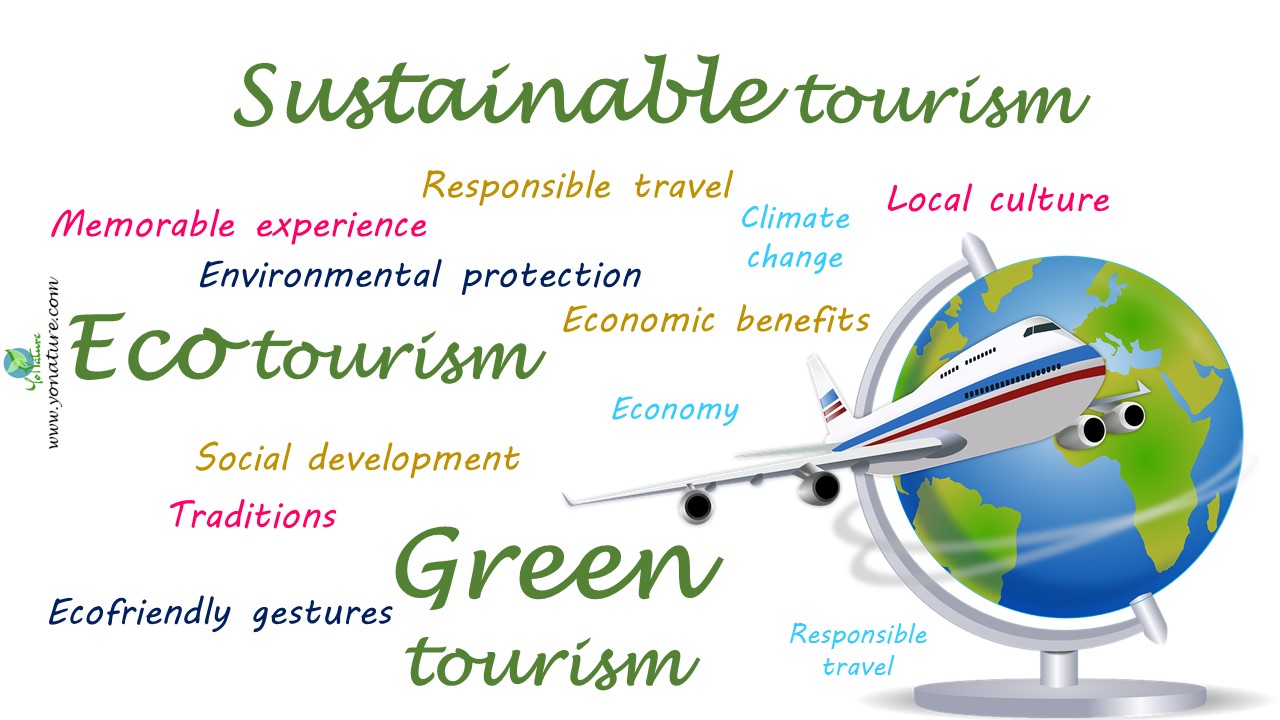
Sustainable tourism is now a new way of practicing tourism .
As it is, tourism plays an important role in the economy of most countries. In the past, mass tourism led to several detrimental impacts on the environment, physically and socio-culturally. But, since the environmental movement in the 1970s/80s, the focus of the tourism sector changed. The well-being of the host community became the priority instead of the tourists.
Over time, people used several terms to define this new type of tourism. Some examples are alternative, endemic, sustainable, eco and green tourism.
And eventually, different organizations defined the different terms in relation to the purpose of the tourism activity.
We will concentrate on the definitions of sustainable tourism, ecotourism and green tourism mainly. Though people use these three terms interchangeably, they actually refer to different things.
Sustainable tourism
History of sustainable tourism.
Since the 1992 Earth Summit in Rio, all economic sectors had to decrease their environmental impact s. They were compelled to be more sustainable. Sustainable here refers to economic vitality, social equity and environmental preservation. The tourism sector, one of the largest global industries, had to comply as well.
In the early days, tourism suppliers basically supported environmental conservation. Many also advocated for the preservation of local culture and traditions. But, generally, researchers, businesses and academicians mostly debated the idea of sustainable tourism. The media also did not give it much attention.
As the years rolled by and the threats of climate change became more visible, sustainable tourism became an obligation.
Definition of sustainable tourism
According to the UNWTO,
Sustainable tourism is tourism that takes full account of its current and future environmental, social and economic impacts. It addresses the needs of visitors, the environment, host communities and the industry.
Basically, sustainable tourism is the integration of the sustainable development principles into the tourism sector. A harmony must exist between the environment, economy and society.
Hence, it is not a sub-sector of tourism per se. Rather, it is an umbrella under which all forms of tourism fall, including eco-tourism.
Sustainable tourism rests on specific development guidelines and management practices. It also includes both mass and niche tourism.
Principles of sustainable tourism
Basically, the principles for sustainable tourism are
- Using environmental resources wisely,
- Respecting and conserving socio-cultural authenticity of host communities
- And providing economic benefits to host communities.
Thus, sustainable tourism is quite complex in nature and requires the efforts of all stakeholders including the government. It is also a continuous process, with adjustments as required.
At the same time, the experience must enrich the tourist significantly. It must raise awareness of environmental issues . And encourage sustainable gestures .
Ways to be sustainable in the tourism sector
So, all stakeholders play an important role in making the tourism sector sustainable. It includes small, local operations to large, international companies. As it is, the sector provides various services like accommodation, transport, attractions and food. Hence, we can implement sustainable practices at different stages and in many activities.
1. Sustainable practices in transportation
i. airlines.
- Maintain a young fleet as far as possible as new technology helps to reduce carbon emissions .
- Also, choose non-stop flights.
- Airlines should encourage high load factor flights because when more people travel, the energy used per passenger decreases.
- And reduce operating weights as the less planes weigh, the less energy they use.
II. Cars
- Generally, promote the use of low-emission cars.
- Or replace old cars with environmentally friendly ones .
- And avoid SUVs as far as possible.
III. Railways and coaches
- Use renewable sources of energy.
- Recycle materials as much as possible.
- Likewise, renew infrastructure to attract more customers and decrease energy use.
- And improve customer service and trips to attract more tourists.
2. Accommodation
- Save energy with better air conditioning/heating systems.
- Generally, use energy-saving lighting systems such as sensors or even control vegetation growth.
- Opt for local foods to reduce transport costs.
- Likewise, invest in renewable energy sources like solar power .
- And recycle waste .
3. Tour operators
- Re-think and re-structure their distant destinations with closer ones.
- They should also develop low-carbon holidays such as train-based trips.
- And offer carbon offsets for flights.
4. Tourists
- Minimize air travel or choose alternative methods.
- Even travel less frequently and stay for longer periods of time.
- Likewise, voluntarily choose to offset flights that they cannot avoid.
- And choose airlines/destinations/services/activities that are eco-friendly.
Eco-tourism
Definition of ecotourism.
According to The International Ecotourism Society,
‘ecotourism is the responsible travel to natural areas that conserves the environment. It also sustains the well-being of local people and involves interpretation and education.’
So, ecotourism is not only engaging in nature-based activities. Rather, it is a way to preserve the natural environment and sustain local communities.
History of ecotourism
Ecotourism first appeared in 1965 when Hetzer coined it with responsible travel. Eventually, other authors used it to refer to eco-development in parks in Latin America and Canada.
During the 1970s/80s’ environmental movement, the term became famous. Mass tourism was heavily degrading the environment and tourists wanted nature-based experiences .
At the same time, people in less developed countries were mutilating their natural resources for agriculture and development. They also realized that they could preserve their natural environment while gaining foreign currency.
Eventually, people used several different terms to promote concepts linked to ecotourism like responsible tourism. Some terms were vague in nature and we no longer use them. Others are basically subdivisions of ecotourism such as wildlife tourism.
Principles of ecotourism
For ecotourism to be successful, proponents must adhere to certain principles. These are:
- Keep environmental, behavioural, social and psychological impacts to a minimum.
- Likewise, respect the culture of host communities and their environment.
- Also, directly finance environmental conservation and host communities.
- Maximize tourist and host satisfaction.
- Build infrastructure that have the minimum impact on the environment.
- And, understand and recognize the spiritual beliefs of indigenous communities and help support them.
Ecotourism in Ecuador as an example
Perhaps one of the most successful ecotourism destination is Ecuador. Historically, it became a famous ecotourism site because of the rare species that inhabit the Galapagos Islands.
Eventually, though, many indigenous groups adopted ecotourism as part of their development strategy.
Today, a wide range of community groups including indigenous people, Afro-Ecuadoreans and mestizos work on diverse ecotourism projects. These range from the majestic Amazon forest to the high sierra and the coast of Ecuador.
Importance of ecotourism in Ecuador
Indeed, Ecuador is one of the most biologically diverse regions on Earth. The Oriente, especially, where the majority of the land belongs to indigenous communities like the Quicha, Achuar, Huaorani and Shuar is very rich.

Ecotourism helped massively in the preservation of natural areas. Otherwise, investors would have destroyed the Amazon forest for oil.
In general, tour operators and NGOs help small communities to make the most of ecotourism based on their own terms. Thus, it allows indigenous people to sell traditional knowledge and use natural resources sustainably.
At the same time, it gives these communities much needed international support when they face tough decisions regarding the exploitation of natural resources. Additionally, it is a form of self-defence for indigenous communities. It helps them preserve their culture, traditional economies and remaining wild places on Earth.
For sure, small rural communities offer memorable experiences to tourists. They share their homes with them and teach them about their local customs and traditions. Or sometimes, they build eco-lodges in their localities with traditional materials and minimum impact on the environment.
Ecotourism activities
In general, ecotourism activities vary greatly from place to place. It typically revolves around the environment and the local customs of the community.
In Ecuador, the main ecotourism activities are
- Visiting the Ecuadorian forests ( mangrove , cloud forest, high mountains etc.)
- Observing the flora and fauna
- Artisanal canoe rides and boat tours
- Forests, cliffs and beaches walks
- Artisanal fishing and octopus catching on rocky beaches
- Preparing and tasting traditional foods and drinks
- Artisanal fabric, jewelry, musical instruments, masks making
- Visits to sacred places, traditional shamans, midwives
Types of ecotourism
There are many subsectors that are related to ecotourism. We define them purely according to the principal attraction or product. They do not necessarily conform to the criteria applied specifically in ecotourism.
So, the main types of ecotourism are principally nature-based, wildlife, adventure, farm and cultural tourism.
Nature-based tourism
As a general rule, nature-based tourism refers to tourism where the natural features of the environment are the centre of attraction. It includes broad trips to visit landscapes or more specialized products like wildlife sightseeing. Camping, stargazing and birdwatching are examples of nature-based tourism.
Wildlife tourism
As for wildlife tourism, it is a large part of nature-based tourism itself. Wildlife tourism products vary greatly from terrestrial to marine tourism. The most common activities are safaris, guided rides, sport hunting, recreational fishing and animal feeding.
Adventure tourism
Adventure tourism refers to commercial tours where the principal attraction is an outdoor activity. This activity typically depends on the natural features of the terrain. It is exciting for the tourist and generally requires specialized sports equipment. Examples include skiing, snowboarding and surfing.
Farm tourism
Farm tourism in fact originates from bed-and-breakfast establishments and ranches. Today, many landholders are investing in it to provide tourists a unique experience of rural life and farming. Some examples are French vineyards, rice paddies in South-east Asia and dairy farms in the Swiss Alps.
Cultural tourism
In cultural tourism, tourists travel to experience different cultures and traditions. The aim is to learn and understand traditional cultures and visit historical sites. It includes folkloric music, art and dance, museums and traditional artefacts. An example is the traditional Kawa hot bath, in the Philippines.
Green tourism
History of green tourism.
The term green tourism emerged in the 1980s referring to small groups of tourists visiting natural areas. They had the minimum impact on the environment. Eventually, people used it interchangeably with ecotourism and sustainable tourism.
Definition of green tourism
The UNWTO defines green tourism as
‘Activities that can we can maintain indefinitely in their environmental, social, economic and cultural contexts.’
Principles of green tourism
Basically, green tourism is a way to promote sustainable tourism.
As it is, the tourism industry will always have impacts given the large number of sectors involved. But, we can decrease these impacts.
Green tourism thus aims to help sectors engage in activities and make choices that have less environmental impacts, benefits society and the economy.
It includes ways to
- Reduce energy use,
- Also, minimize food miles,
- Promote biodiversity,
- And adopt sustainable practices.

Difference between sustainable tourism, ecotourism and green tourism
- Sustainable tourism refers to the incorporation of sustainable practices in the tourism sector.
- Ecotourism is a branch of tourism.
- Green tourism is a catalyst to achieve sustainable tourism.
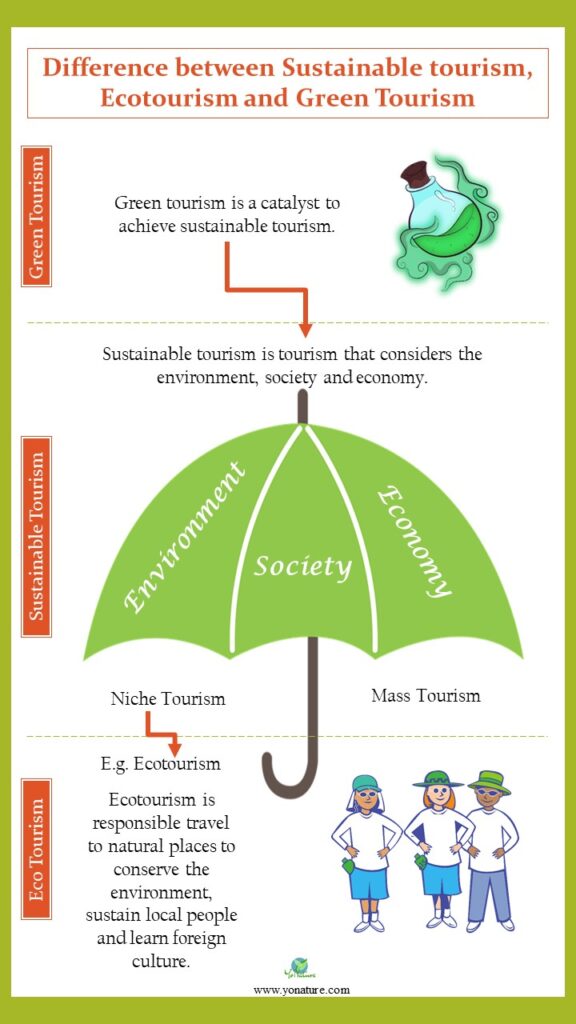
- Buckley, R., 2009. Ecotourism: Principles and practices . CABI.
- Maldonado-Erazo, C.P., del Río-Rama, M.D.L.C., Noboa-Viñan, P. and Álvarez-García, J., 2020. Community-Based Tourism in Ecuador: Community Ventures of the Provincial and Cantonal Networks. Sustainability , 12 (15), p.6256.
- Weaver, D.B. ed., 2001. The encyclopedia of ecotourism. Cabi.
Category: Human activities Tags: characteristics of sustainable tourism , difference between sustainable tourism and green tourism , ecotourism activities , ecotourism example , ecotourism meaning , green tourism examples , green tourism meaning , green tourism practices , how to achieve sustainable tourism , how to be sustainable in tourism sector , importance of green tourism , principles of ecotourism , principles of green tourism , principles of sustainable tourism , Sustainable tourism meaning , types of ecotourism , ways for tourism to be sustainable
4 Comments on “ Sustainable Tourism, Green Tourism, Ecotourism Explained ”
Pingback: Volcanic Eruptions: Positive and Negative Effects - Yo Nature
Pingback: Positive impacts of tourism on the environment - Yo Nature
Pingback: Negative impacts of tourism on the environment - Yo Nature
Pingback: The purpose of ecotourism with examples - Yo Nature
Leave a Reply Cancel reply
Your email address will not be published. Required fields are marked *
Save my name, email, and website in this browser for the next time I comment.
Get News by Email!
- Environment
- Human activities
- Uncategorized
contact[at]yonature[dot]com
Recent Posts
- The Hidden Threat: Tree Diseases – Causes, Types, and Ways of Dealing with Them
- Positive and Negative Impacts of COVID-19
- Volcanic Eruptions: Positive and Negative Effects
- Volcanic Eruptions Explained: Types and Examples
- Effects of Droughts: Positive, Negative, Examples
- Privacy Policy
- Terms and Conditions
Secure Site
Copyright © 2024 · All Rights Reserved · Yo Nature
Theme: Natural Lite by Organic Themes · RSS Feed


What is Green Tourism?
Our promise to you.
Founded in 2002, our company has been a trusted resource for readers seeking informative and engaging content. Our dedication to quality remains unwavering—and will never change. We follow a strict editorial policy , ensuring that our content is authored by highly qualified professionals and edited by subject matter experts. This guarantees that everything we publish is objective, accurate, and trustworthy.
Over the years, we've refined our approach to cover a wide range of topics, providing readers with reliable and practical advice to enhance their knowledge and skills. That's why millions of readers turn to us each year. Join us in celebrating the joy of learning, guided by standards you can trust.
Editorial Standards
At WiseTour, we are committed to creating content that you can trust. Our editorial process is designed to ensure that every piece of content we publish is accurate, reliable, and informative.
Our team of experienced writers and editors follows a strict set of guidelines to ensure the highest quality content. We conduct thorough research, fact-check all information, and rely on credible sources to back up our claims. Our content is reviewed by subject-matter experts to ensure accuracy and clarity.
We believe in transparency and maintain editorial independence from our advertisers. Our team does not receive direct compensation from advertisers, allowing us to create unbiased content that prioritizes your interests.
Green tourism, a form of ecotourism, is low-impact tourism with an eye toward protecting the environment and culture of an area. The United Nations has set up certain criteria for ecotourism, but green tourism can cover a wide range of standards and conditions, from fully compliant to less stressful on the environment than standard tourism. There are many opportunities for green travel available worldwide.
The number of tourists traveling the world has been increasing, which makes green tourism not only preferable but a necessity in some areas. It might seem wiser to some people to protect natural habitats and pristine, fragile environments by banning visitors completely to these areas, but many areas depend on the income from tourism to support the local economy. Green, sustainable tourism is considered offer the best of both worlds, protecting the ecology of an area while keeping local schools and businesses thriving.
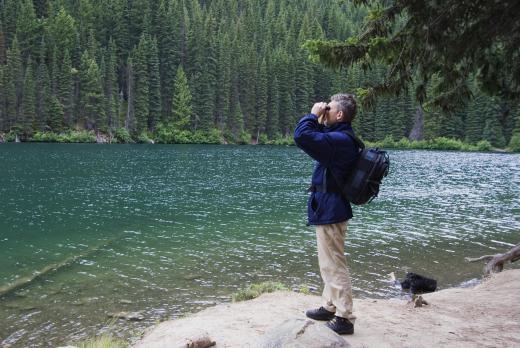
Green tourism doesn't necessarily mean a vacation spent roughing it with little or no comforts. On the contrary, many people believe that it can be a wonderful adventure. Ecotourism resorts and ecolodges exist in almost every style and taste. From recycling and gray water systems to tents on tree house-like platforms with a rain forest canopy, there are numerous vacationing options. Simple efforts, such as keeping to designated pathways, eating where locally grown cuisine is served and visiting cultural areas instead of typical tourist attractions, can go a long way toward "greening up" a standard vacation.

A very green holiday can be spent studying the local flora, fauna and cultural heritage of the area, as well as learning ways to protect and preserve it. Guides, tours and wildlife-viewing platforms help tourists experience all that an area has to offer while making little or no impact on the environment. There also are trips available in which vacationers take an active part in improving the local area by working to preserve the natural habitat, helping to build a school or performing other services that benefit the area. These vacations can be a lot of work, but many people find them to be very rewarding and interesting learning experiences.

As green tourism becomes more popular, there are likely to be more vacationing options available. More resort areas likely will take steps to have less of an impact on the surrounding environment, and sustainable tourism could easily become the standard. Local economies might be able to take full advantage of the booming tourist trade without compromising the local environment, allowing tourists to enjoy the beauty that these areas have to offer for many years to come.
Related Articles
- What Is Heritage Tourism?
- What Is Archaeological Tourism?
- What Is Garden Tourism?
- What Is Water Tourism?
- What is an Ecolodge?
- What is Sustainable Tourism?
Our latest articles, guides, and more, delivered daily.

Sustainability Success

Green Tourism – QUICK Eco Friendly Guide For Tourists
What is green tourism? How to become an eco friendly tourist? Why is sustainable tourism so important, and how you can make a difference yourself? What are some examples of green tourism? In this article will be the answers to these questions, as well as explain some of the similar but different terms you may hear about this topic. Read on!

Throughout the year 2018, it is estimated there were about 1.4 billion international tourist arrivals, just over a fifth of the world population. Tourism is huge, and its negative impact on the environment and the climate is huge as well.
The number of tourists around the world has plummeted as a result of the coronavirus pandemic, and still remains far less than what they were before the pandemic, but there is little doubt that they will rise to similar levels again one day, and eventually even higher. It is incredibly important that travel becomes more sustainable in the future so that its negative impacts are reduced.
If you would like just a quick summary of green tourism , watch the above video! Then keep reading to learn more! For more amazing sustainability videos , visit our video gallery and subscribe to the sustainability success youtube channel .
The Meaning Of Green Tourism, Ecotourism and Sustainable Tourism

So what exactly is meant by green tourism ?
Green tourism definition: green tourism is tourism with the aim of being environmentally friendly and reducing the many negative effects associated with travel. These negative effects can include environmental destruction, the unethical treatment of wildlife and animals, damage to communities and their heritage, and the high amount of greenhouse gas emissions from air transport.
Green tourism usually involves things like visiting natural, untouched areas in responsible, non-damaging ways, getting to your destination with as little greenhouse gas emissions as possible, and avoiding tourist attractions that are harmful to nature or to society. Another aim of eco-friendly tourism is to support the local community in the location that you’re traveling to by benefiting their economy, preserving their heritage, and improving their wellbeing.
As you can tell, green tourism is somewhat of a vague and broad term, at least nowadays, which is often taken advantage of by businesses who advertise themselves as being “green” despite taking only minimal measures to reduce the negative impacts of their business. You should keep this in mind when you’re trying to plan more eco friendly trips , so you can avoid making use of businesses that do not have responsible business practices.
Often used in this topic, Ecotourism and Sustainable Tourism are two similar but more specific terms that are also worth remembering.
Ecotourism has a similar meaning to green tourism but has a more precise definition. It means traveling in a responsible way to natural, wild areas , with the aim of supporting its conservation and supporting the local people, as well as observing the natural world and learning about it. Travelling to built-up areas would not be considered ecotourism even if it was a completely environmentally friendly trip .
Sustainable tourism is a slightly different concept. It covers every aspect and form of tourism and the destinations that people travel to, not just natural areas . The aim of sustainable tourism is to reduce the negative impacts of tourism as a whole as much as possible while maximizing the positive ones, making the entire industry sustainable over the long term.

Finally, geotourism is another form of green tourism focusing on sustainable tourism in natural and cultural heritage sites. This type of tourism is still in its early stages of development, but it is growing in popularity as more and more people become interested in sustainable and responsible travel.
Geotourism can include activities such as hiking, camping, bird watching, and visiting heritage sites, and staying in eco lodges overnight. Nowadays, eco lodges are available in the USA and all over the world and are a great option for eco friendly travelers. This is a great way to learn about the history and culture of a place while also enjoying its natural beauty.
Why are Green Tourism and eco friendly tourists so IMPORTANT?

The main goal of green tourism is to reduce the negative effects of tourism, both on the environment and on the communities that are involved in tourism. It is crucial for the eco friendly tourist that wants to travel sustainably to be aware of those issues. But what exactly are these environmentally negative aspects of tourism and why are they so important to remedy?
Let’s begin with the environmental impacts. An important place to start is with the impact of air transport, the primary method of long-distance travel. Aircraft produce a significant amount of greenhouse gases, primarily CO2 but also other substances, and air travel is thought to be responsible for around 5% of global warming as a result. Although aircraft have become significantly more efficient over time, total emissions are still rising quickly because of the continued increase of people traveling by air. Aircraft are also responsible for noise pollution and air pollution, which can both have severe health effects on both humans and animals.
Another problem is the environmental damage that can be caused when people are too careless about traveling through natural environments. It is sadly a common occurrence for tourists to litter in natural areas, and when a lot of people travel through an area it will inevitably lead to erosion and a loss of vegetation in the area.
Example of unsustainable tourism

One well-known example of tourism negatively affecting a natural area is the situation on Mount Everest. The mountain attracts hundreds of climbers every year, and with every year that goes by, the problem of waste and litter on the mountain worsens further, with countless items such as oxygen canisters, camping and hiking supplies, and other waste being left behind. Attempting to remove these things from the mountain is dangerous at best and impossible at worst, as the higher you go, the progressively more difficult it becomes to carry anything back down with you. Despite this, there have been some successful cleanup operations that have removed large quantities of litter from the mountain.
Increased tourism in the area around Mount Everest has also led to damage being caused to the habitats of vulnerable animals that live there, such as the snow leopard and Tibetan blue bear.
Possible effects on the wildlife
Tourism can also harm wildlife in ways that may not be obvious. Even a seemingly benign activity can be harmful, for example viewing wild animals from a distance at a safari, as even the mere presence of humans and vehicles can cause wild animals to become more stressed and change their behavior.
Positive effects of green tourism
Although the negative impacts of tourism on the environment are many, it’s also important to remember the positive effects that it can have. For example, tourism to pristine natural locations can encourage conservation efforts, and by traveling to natural locations people can be educated on why it’s so important to protect the environment .
Another very important part of green tourism is to consider the impact that it has on various communities around the world.
For communities that are heavily involved in and affected by it, the effects of tourism are not all good or all bad. Tourism can have a lot of positive effects on a community and cultural sustainability , such as on the economy, which improves the quality of life, creates more jobs, lifts people out of poverty, and gives them more opportunities. It also allows people to learn about and experience other cultures first-hand, facilitating understanding and friendship.
The economies of many countries rely heavily on tourism, and as a result, they have suffered greatly during the pandemic. Increased focus on eco friendly tourism can also provide additional incentive to take the restoration and preservation of the natural environment, and historical and cultural sites more seriously, as well as aid in the preservation of cultural practices and traditions.
Be aware of the negative effects tourism can have: pursuing eco friendly solutions
The negative effects of tourism on communities around the world, both big and small, are also very real and have to be remedied in order for tourism to become truly sustainable .
To start with, when a very large amount of people travel to a particular place, it can create problems with large crowds and congestion, which is known as over-tourism . This overcrowding can cause a lot of inconvenience and stress to local residents, disrupting their daily life. This can create resentment and conflicts between the locals and tourists. It also creates a negative experience for the visitors themselves, since it’s hard to enjoy a location when it’s flooded with other tourists.
Another issue is that tourism can cause damage to a community’s uniqueness and way of life. For instance, when large companies decide to set up shops in areas that have become popular for tourism, they create a lot of competition for the local businesses that make it harder for them to survive, and many of them could be put out of business.
The effects that tourism has on the environment and on society are very complicated and vary from place to place, but hopefully, this section has given you a general understanding of the importance of green tourism and becoming an eco friendly tourist pursuing sustainability for your trips .
Finally, always keep in mind that you can make a difference and be part of the solution! Try to apply as much as possible the 6 Rs of sustainability also during and for your travels will definitively help you to become a green tourist and support the development of more eco friendly ways to travel and explore the world while respecting the environment .
Pursuing eco-friendly tourism solutions is a growing example of sustainability and how this industry can help us to protect the planet for future generations.
Sustainable Tourism Examples And Advice For Travelling Sustainably

So, now that you know what traveling sustainably is and why it’s so important, you’re probably wondering how you yourself can contribute and be eco-friendly when traveling.
Here are some examples of sustainable tourism for being a responsible tourist:
- Ensure that the businesses you’re supporting during your trip are sustainable . As mentioned before, many businesses who brand themselves as being “green” actually have very unsustainable business practices. You should do research on the businesses that you’re planning on interacting with during your trip and see whether they have actually made commitments to being sustainable, and refrain from interacting with businesses that haven’t. This is the first important step to promoting green tourism: always remember to “vote” for truly eco-friendly businesses with your wallet. This will encourage more companies to care more about the environment to attract a growing number of green tourists .
- Support the local communities that you’re visiting . This means that when out and about at your holiday destination, try to shop and eat from local stores and restaurants and use the services provided by local, small businesses rather than any of the larger businesses and chains that may be in the area. If you want a guide during your stay, try to find a local guide. This will benefit the local people and their economy and will help to preserve their uniqueness and way of life, and additionally, it will give you a more unique and authentic experience of the area that you’re in. Taking the time to learn some of the languages spoken in the area you’re in will also be very useful for this.
- Figure out ways to leave as small carbon and environmental footprint as possible . For example, you could try to use air transport as little as you can, since air travel is a massive contributor to greenhouse gas emissions. Something important to note is that the per-person contribution to emissions is very high for air travel, meaning that if you fly on a regular basis, it likely accounts for a large amount of your own carbon footprint, especially if you fly first class. When it’s possible to do so, a better choice is to use other forms of public transportation such as buses or trains, or even better, use a bicycle or walk when you can.
- Other things you could do to be an environmentally conscious green tourist are: Avoid any tourist attractions and activities that are harmful to the environment and the local wildlife or that don’t support and benefit the local communities. Another good thing to do is to travel off-season, as this helps to prevent overcrowding of tourists at your destination, which would inconvenience the locals, and it will mean you’ll have more space yourself to fully enjoy your trip and have a more authentic experience. And, importantly, remember that when you’re traveling overseas, you’re visiting somebody else’s home. Always be respectful to the people who live there and to the nature that they live near.
If you follow the green tourism examples listed above you will be much more eco-friendly during your holidays.
In addition, in the future, there may also be other ways to travel, including having eco-friendly vacations on solar yachts . In fact, these catamarans offer the possibility to travel extensively without any emissions, because they are powered by solar energy !

Hopefully, this article has clarified what is meant by green tourism and why it’s so important for us to take action on reducing the negative impacts of the tourism industry.
Traveling in the modern world without leaving a trace on the environment can be very difficult at times, but travelers who take sustainability seriously still have many options for reducing it and for helping to make a difference, especially if you know how to think outside of the box. You should take into account the places that you’re traveling to, what things you can see and do there, and be creative in thinking of ways to have a positive impact while on your eco friendly journey !
Related topics
- The Magic Of Ecotourism In Belize (Unmissable Experiences!)
- Mexico Ecotourism (Discover 10 Hidden Gems!)
References And More Information
- Ecotourism – Wikipedia
- Sustainable Tourism – Wikipedia
- Overtourism – Wikipedia
- Tourism – Our World In Data
Home » Everyday actions » What is the Difference Between Green, Eco-, and Sustainable Tourism?
What is the Difference Between Green, Eco-, and Sustainable Tourism?
Filed Under: Everyday actions Last updated September 8, 2020
Have you ever heard the term “green hotel”? How about “sustainable resort” or “eco-friendly tours”? The green travel market can be difficult to navigate with so many terms being thrown around. Businesses sometimes use these terms dishonestly in an effort to appeal to a growing movement of conscientious travelers without actually having any environmentally or socially responsible policies in place. Here, we hope to shed some light on what these terms really mean.
Green tourism was used by researchers in the 1980s in a study that described the hotel industry’s practice of placing green placards in each room that encouraged guests to reuse their towels. The study found that many hotels ultimately made little to no effort to actually conserve resources or reduce waste; they just wanted to appear to be environmentally friendly, or “green.” It’s important that travelers dig a little deeper into hotels’ green claims when researching before booking. Fortunately, most environmentally-friendly hotels have information on their websites about their green initiatives that make it easier to learn about the concrete measures they are taking to conserve natural resources, protect plants and wildlife, and contribute to the well-being of local communities.
Ecotourism is defined by the International Ecotourism Society as: “responsible travel to natural areas that conserves the environment and improves the welfare of local people.” The key principles of ecotourism include minimizing impact, protecting biodiversity, building environmental awareness, and respecting local culture. Typically, the primary attractions for ecotourists are flora, fauna, and cultural heritage.
Sustainable tourism businesses support environmental conservation, social development, and local economies. Examples of sustainable business practices include conserving water and energy, supporting community conservation projects, recycling and treating wastes, hiring staff from the local community, paying them just wages and providing training, and sourcing locally-produced products for restaurants and gift shops. Sustainable tourism businesses take concrete actions to enhance the well-being of local communities and make positive contributions to the conservation of natural and cultural heritage. In doing so, they often cut down on their own costs and preserve the longevity of their businesses in addition to attracting responsible travelers. In order for sustainable tourism to thrive, it has to be profitable for business owners.
Sustainable tourism and ecotourism are similar concepts and share many of the same principles, but sustainable tourism is broader; it covers all types of travel and destinations, from luxury to backpacking and bustling cities to remote rainforests.
Support Our Work
Helping businesses improve sustainability

Green Tourism promotes greener ways for businesses and organisations to operate, by offering our members advice on:
- Reducing energy use
- Saving water
- Efficient & eco-friendly waste disposal
- Ethical buying
- Staying local & seasonal
- Minimising food miles
- Promoting biodiversity
- Adopting a smart, sustainable outlook from top to bottom
The awards certification programme we run recognises the commitment of tourism businesses which are actively working to become more sustainable. Our Bronze/Silver/Gold awards are acknowledged worldwide as an indicator of good environmentally-friendly practice, and are a great way of progressing on a green journey as well as acting as a hallmark of ‘green quality’, attracting custom from increasing numbers of eco-minded visitors.
Our technical experts offer practical advice and lots of support – this means that saving energy and changing dated and unsustainable ways of doing things can be much more straightforward than you might think.
We want acting responsibly to become second nature to businesses in our industry, and becoming a member of Green Tourism is a brilliant first step to getting greener.
Green Tourism Criteria Definitions
Green Tourism understands that sustainability is the key to success within the modern hospitality industry. In order for the industry to be successful both nationally and internationally it is important that you have a system in place to help set targets and to show continually improvement.
DOWNLOAD >
We champion investment and improvement in local communities. When businesses devote some time and energy to contribute to local people, it becomes part of investing in a truly sustainable and ethical mindset. By encouraging staff and individuals to play their part in a business’s green journey, they will feel respected and valued; as well as ensuring a happy and eco-aware workforce.
Living and operating sustainably is a process that involves promoting and caring for the natural environment, helping conserve the local area and its economy and supporting local suppliers of ethically-produced, seasonally-grown food and drink. We encourage our members to actively introduce guests or consumers to genuine experiences, both in the great outdoors and those involving arts, craft and culture.
We are committed to a low carbon future and finding new ways to reduce our industry’s footprint. We aim to inform and inspire our participating businesses about the circular economy, ecological and cultural diversity and ensuring efficient use of our planet’s resources. We work with selected partners and affiliates to strengthen our offer as one of the world’s leading eco-friendly accreditation organisations.
WHAT TO DO NEXT?

Why you should join the growing Green Tourism family

A transparent explanation of our registration & fee structure

Take the FREE 10 minute quiz and get instantly graded

“Joining Green Tourism was one of the best things we ever did. We have halved our waste to landfill by 50% saving us nearly £90,000 per year and we have made large savings on our utility bills.”
Devon cliffs holiday park.

“Caring for the environment is fundamental to our business. Our guests expect us to be responsible. Our businesses rely on the landscape – why would we not want to protect it?”
Langdale hotel .
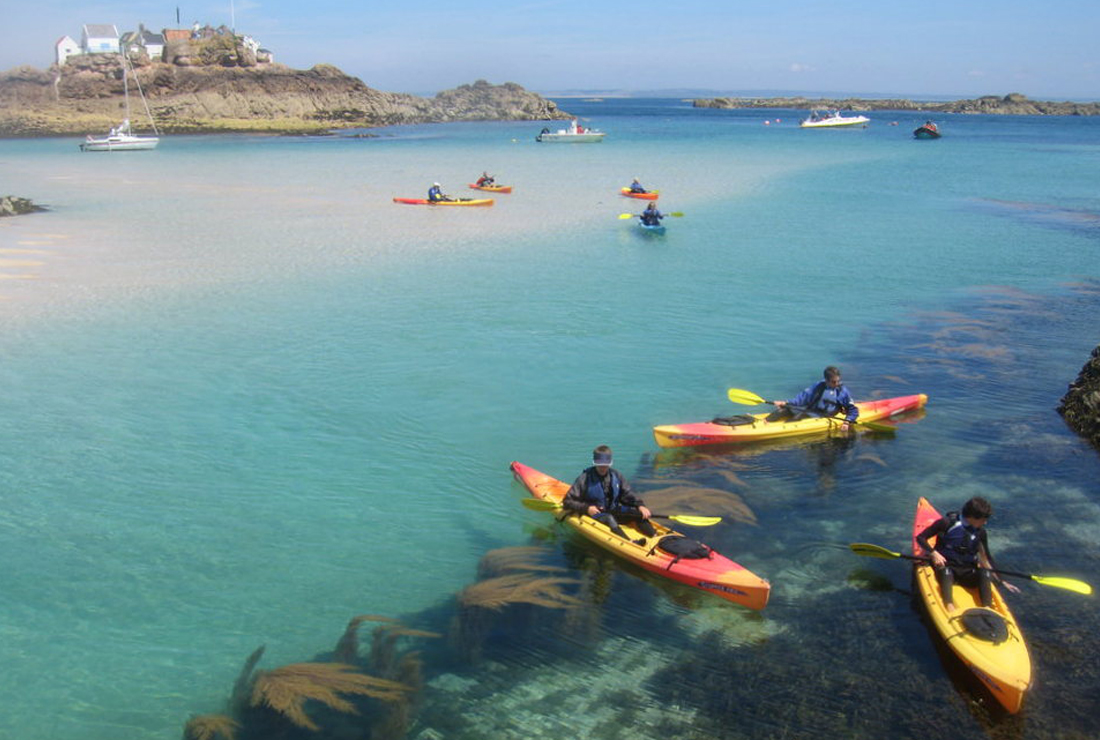
“The eco credentials of a business are becoming more important. We’ve started to get asked – especially from UK organisations – about our Green, Corporate Social Responsibility (CSR) & supplier screening policies.”
Jersey kayak adventures.

“We have been told by many guests that they choose to stay with us because of our green values and our Gold award. Other guests make frequent comments about our use of local and home-grown produce.”
Burnbank b&b, cookie policy.
By using this site you agree to our cookie policy
How do travel and tourism distribution channels work?

By Kevin Tjoe — 29 Nov 2021
tourism distribution channels
Updated January 2023 – A tourism distribution channel refers to the stakeholders and methods involved in taking a tourism product from the supplier to the consumer. Typically, the chain of distribution in tourism refers to the businesses and platforms involved in selling, distributing, and bundling tourism products. However, more components are involved across the entire distribution chain, including suppliers, wholesalers, resellers, and consumers.
By aligning your business with existing distribution channels, you connect with important stakeholders in the industry. This creates more efficiency in your marketing efforts and ultimately grows your tourism and activity business.
What is a distribution channel?

Tourism distribution channels are the avenues tourism products and services are made accessible to consumers. Typically, tourism products are sold directly by the primary provider or through a series of intermediaries. If brokers or travel wholesalers are involved, this is called indirect distribution. Consumers can access these products via various mediums, including traditional channels such as travel agents, government bodies such as information centers, and even other tour and activity operators .
How it works
While direct bookings may still account for a large part of business, branching out through additional distribution channels can help you to maximize your brand exposure, reduce risk and ultimately boost your bookings. Many distribution channels will have access to much larger marketing spend or broader customer bases. This can provide you with access to more exposure and quality bookings.
Typically speaking you’ll provide your availabilities to them, and they’ll, in turn, bring in bookings at a pre-agreed commission rate.
The chain of distribution
The chain of distribution in tourism refers to the businesses and platforms involved in selling, distributing, and bundling tourism products. This process begins with the primary tour and activity provider all the way to the end consumers experiencing it.
Generally, there are four steps to the distribution chain:
1. Suppliers/principals
2. Wholesales
3. Resellers
4. End consumers
The distribution chain for a particular product can go through all of the steps depending on its distribution channel. For example, direct distribution won’t require wholesalers or resellers, as suppliers sell their products directly to consumers, whereas indirect distribution requires intermediaries.

Suppliers or principals include the primary providers across accommodation, transportation and car hire companies, attractions, and experiences. Examples include hotels, Airbnb hosts, airlines, and the attractions such as the Empire State Building.
Wholesalers
Wholesalers develop packages of travel products for retailers to sell on, though in some cases they may actually sell directly to the consumer. These packages or itineraries might include tours, activities, accommodation, transport, and/or travel insurance.
Wholesalers can include:
- Destination Management Organisations (DMOs) or inbound tour operators, such as government tourism boards or tourism authorities
- Global Distribution Systems (GDSs), are used by retailers such as OTAs to easily see an inventory of availability from tourism operators.
Resellers purchase and bundle experiences to be sold directly to the consumer. A common example includes traditional travel agents, which create personalized travel packages. However, online travel agents (OTAs) such as Expedia and Tripadvisor are more commonly used these days. They provide accessibility to a range of tourism products such as airline tickets, hotel bookings, tours and activities, and more.
Consumers are the most critical component of the distribution chain. That is because they are the end user of the product. The choices and decisions consumers make have a huge impact on the rest of the distribution chain. Trends in consumer behavior, or individual decisions all influence how tourism products are marketed and sold.
Advantages of tourism distribution channels

Broadening your distribution channels involve heaps of advantages. Here are the top five:
Connectivity
By aligning your tour and activity business with the broader industry, you can connect with important stakeholders across every step of the tourism distribution chain. Forming strategic partnerships with resellers and tourism platforms enables you to access a broader customer base. This provides you with a greater opportunity to increase your sales.
Generating 100% of your revenue via direct marketing requires a great deal of investment in time and money. Existing distribution channels generally have larger marketing budgets that they can spend to attract more customers.
Typically, as the supplier, you’d only pay a fee when a booking has been made via their channel – making your marketing and sales costs predictable. This means you gain additional resources to expend on other areas of your business, such as improving your customer experience.
Flexibility
Given the wide array of potential partners, you have the freedom and flexibility to test and experiment with different methods of promoting your business. Plus, it’s more convenient for your customers to book your services through an array of trusted partners. This helps to increase customer loyalty and satisfaction.
Transparency
Utilizing existing distribution channels can make the entire booking process more transparent for both you and the end consumer. On the tour operator side, it provides you with a clearer understanding of your customer behavior and adjusts your marketing strategies for better outcomes. And on the customer side, information such as reviews displayed on your profile allows them to create informed decisions before choosing to book your services.
Accessibility
Promoting your tourism products via numerous distribution channels means that your customers can book your services where they like; when they like. Furthermore, your products and services will be found across multiple avenues – enabling a wider array of customers to book with you. In fact, operators are using an average of 14 distribution channels according to Arival’s Operator Insights 2021-2022 report.
What are the main types of tourism distribution channels?

There are many ways to get in front of customers, even more so since the rise of digital channels. From travel agents to mobile apps, tourism suppliers have never had more choices regarding promoting their products and services. There are four main distribution channel types. These include:
Traditional channels
Traditional distribution channels often refer to real-world marketing channels separate from online and mobile experiences. Indirect traditional distribution channels can include travel distribution services such as travel agents, tourism information centers, flyers and print/ digital brochures , promotional marketing services, and tour operators . Depending on your products and services, wholesalers can also make up part of your business’ traditional distribution channel.
Online channels
In recent years, online travel agencies (OTAs) have dominated the tourism industry. These online experiences allow users to plan, book, and pay for personalized travel plans through an easy-to-use centralized platform. Often flights, hotel bookings, car hire , and local experiences can be bundled and purchased through a single site, making the process convenient and intuitive. These platforms can also be cheaper due to the relatively low cost of maintaining a website over a brick-and-mortar travel agency.
Mobile channels
Like online channels, mobile distribution channels rely on digital platforms, such as apps, to promote and sell tourism products. Many popular mobile apps which centralize the tourism buying experience have cropped up in recent years. In addition, airlines, hotels, and other major suppliers have begun developing apps to improve customer loyalty and engagement. Other forms of mobile marketing can include SMS marketing, mobile advertising, and cold calling.
Direct channels
Direct marketing and sales channels include anything your business has direct control over and does not involve an intermediary. This type of marketing can occur through traditional, online, and mobile mediums. For example, direct online channels can include your website, direct bookings via a booking system, online chat assistance, and your social media accounts.
While direct marketing efforts via mobile can consist of sending promotional text messages to previous customers, cold calling potential customers, and sending personalized email marketing messages . More traditional measures may include brochures and flyers, a storefront, and salespeople.
Choosing the right tourism distribution channels
As a tour company, it’s essential to understand which distribution channels will achieve the most significant results for your business. While trial and error can bring results over the long run, understanding what makes a channel right for your business can accelerate your path to success.

Identify target market
To understand whether online or offline marketing, direct or indirect distribution, or mobile versus online platforms are best for your business, you need to understand your customers.
Demographics such as age, country of origin, the number of travelers in a party, and the number of children arriving can greatly impact how you communicate and effectively sell your services. For example, an older demographic may be more likely to use traditional channels such as a travel agent, while a young family might be found via online and social media . First, check over your previous customers and try to pull out any obvious trends amongst your clientele, then research which channels best suit your audience.
Research channels
It’s important to research which channels are available to promote your services. But also, it’s essential to understand the reputation of your potential strategic partners. When engaging in indirect marketing, you are aligning your brand with your distributors, so choosing platforms and businesses which align with your values is important. It’s also essential to understand the costs and benefits of each channel and make informed decisions based on what will work for your business.
Evaluate costs and benefits
Each platform and distribution channel will have different pricing models. Some may charge a flat fee for promotional services, others may purchase and resell your services, while others may charge a fee when you receive a booking. It’s essential to understand what level of return you can expect. If you are starting out, finding performance-based pricing options will allow you to pay as you go. Alternatively, flat fee services can sometimes provide a higher return as your budget can go directly to marketing spend.
Track performance
Once you choose one or more channels to distribute your services, ensure you track the performance versus how much it costs to attain them. By understanding the performance of your partnership, it enables you to eliminate ineffective channels and double down on your marketing efforts, thus, cutting you costs.
How can you manage all distribution channels easily?
It can take a lot of time to form and manage strategic partnerships with multiple resellers. Luckily, technology is here to help. A channel manager such as Rezdy Channel Manager can be accessed regardless of your booking system or size of business, and makes it simple to negotiate agreements, manage inventory, rates and manage commissions with a vast range of resellers, from local visitor centers to the big-name OTAs. Live availability of your tours, activities or attractions are visible from one dashboard, dropping the risk of pesky double bookings as well.
You can access the broadest reach of resellers in the industry, connect with desired resellers and easily distribute rates and availability in real-time. Rezdy is integrated with a number of alternative reservation systems and is continuously adding more, providing suppliers access to channel management tools, directly from their existing system. Suppliers with a custom built booking system can connect with Rezdy Channel Manager as well. For Rezdy booking software customers, channel management is included.
Find out more about how Rezdy’s channel management platform can support your business .
Ready to join the thousands of Rezdy customers that managed to grow their bookings by over 25% in 2022? Book a free channel manager demo with a product specialist to see how our products can fit the needs of your tour business. If you are interested in Rezdy’s booking software that includes channel management, you can start a free 21-day trail trial.
If you enjoyed this article, be sure to sign up to receive the Rezdy newsletter , a valuable resource for those who want to stay up-to-date on the latest industry happenings.
Want to know more about reseller commission rates? Read our guide to industry standard commission rates
Broaden your distribution channels with Rezdy
Enjoy 21 days to take a look around and see if we are a good fit for your business.
No obligations, no catches, no limits, nada
Distribution

eBook: Guide to growing your tourism business through distribution & channel management tools

How to navigate API connections with resellers
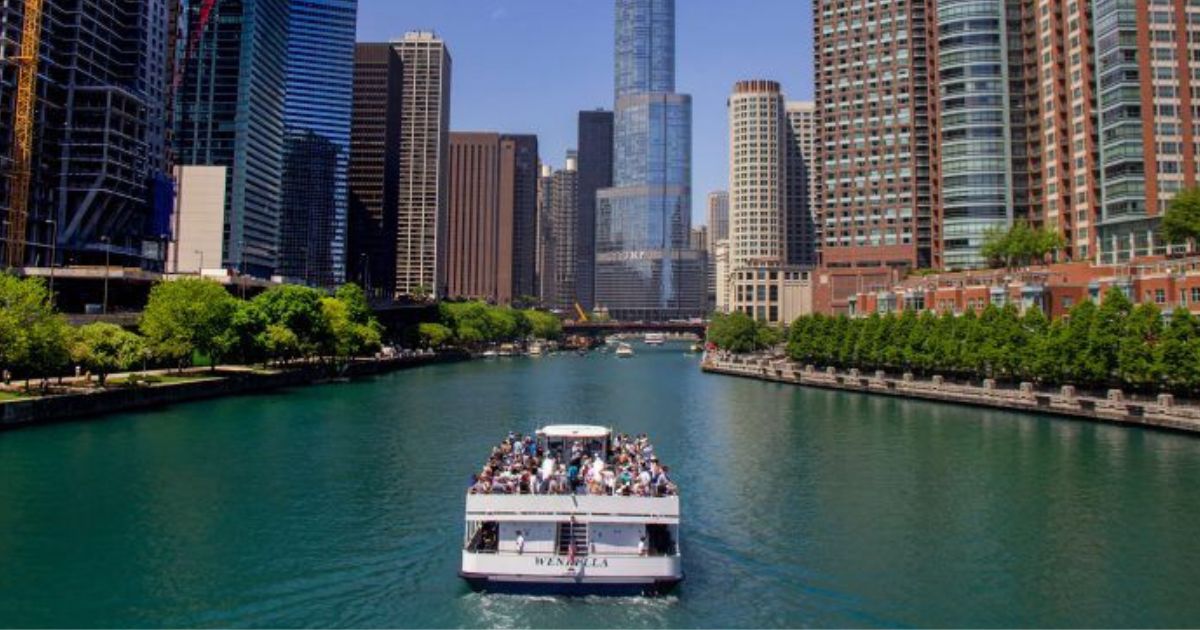
Case Study: Wendella Tours & Cruises
What are Green Tourism, Ecotourism and Sustainable Tourism?
Responsible travel is becoming more and more important for the environment and for the social-economic well-being of the countries. For all of us, to travel in a more sustainable manner has become an important habit and we are here to encourage the development of sustainable travel in Romania.
The environmental movement started to get known around 1960s since when many companies began to market themselves as environmentally friendly. As the tourism market is continuously changing we want to share our opinions and information about the sustainable side of tourism.
Green Tourism
From its beginning, green tourism was known as a small scale tourism that encouraged people to visit natural areas and minimize the impacts of tourism on the environment. The term is used for businesses with an environmentally friendly activity. However, more and more lately, green tourism has been oftentimes used by businesses that do not put that much effort into making their activity more sustainable and the term became more known for greenwashing. Greenwashing refers to companies that are more interested in becoming known for its green tourism and less for its contribution to the environment and local communities.
Ecotourism is referring to a niche of tourism that has as purpose visiting natural and unspoiled tourist areas without having a great impact on the destination, and is often referred to as the alternative to mass tourism . Furthermore, it is usually used for describing the tourism where the flora and fauna are the principal attractions, and rarely referred to for urban destinations.
Ecotourism is focused on conserving both the terrestrial and marine environments. The principles that are at the core of ecotourism are reducing the impacts of tourism on the ecosystems, improve the awareness for good environmental practices for travelling, enhancing the importance of establishing and operating low impact tourism facilities. Furthermore the essential value of ecotourism has to be of ensuring long term sustainability of the travel industry by bringing together local communities, tourism industry and nature preservationists.
The International Ecotourism Society defines Ecotourism as “responsible travel to natural areas that conserves the environment, sustains the well-being of the local people, and involves interpretation and education.”
As tourism is an important industry and is always growing as industry, it doesn’t always help the environment and local communities. Ecotourism and sustainable tourism (that will be discussed further on) came to gain popularity in times of the growth of mass tourism.
Some examples of ecotourism spots in Romania are:
- Piatra Craiului - Zarnesti in Brasov county
This accredited ecotourism spot has become popular as tourists come to see the bears at Piatra Craiului Natural Reserve. The area is as well a renowned rural location that offers incredible experiences based on cooking traditional and organic dishes.

- The Bison Land in Neamt County
The Bison Land has an important value for tourism in Romania thanks to its monasteries the protected area of Vanatori Neamt Nature Park. It was as well included in Top 100 most sustainable destinations in the world in 2017.
- Mara – Cosau - Creasta Cocosului
Everyone can agree that Maramures plays an important role in the Romanian rural tourism. This area in Maramures makes everyone turn back in time and experience the deep-rooted traditions and way of life that are still kept alive. Furthermore, for nature lovers, Creasta Cososului (1450m) offers incredible views with its unusual shaped rocky peak. Due to its vast wilderness areas, wild animal species populate the area such as wild boars, bears, and many others.
Sustainable tourism
As the World Tourism Organization confirms, sustainable tourism development requires the participation of the stakeholders in a well-contoured political environment. Creating sustainable tourism development is a long term and continuous process that needs monitoring the impacts of tourism on the destination, and introducing corrective measures along the way. Tourists are also an important part of the development, therefore a high customer satisfaction along with meaningful awareness is necessary as well.
Sustainable tourism refers to a wider focus of tourism than ecotourism and is defined as being the tourism boosts the economy, does no harm to the environment and sustains the local community.
In Romania, sustainable tourism is maintained by supporting the local communities, the local economy, and taking environmentally friendly actions and measures. More and more companies in Romania have tried, despite the low governmental support, to implement and make their businesses as sustainable as possible by taking energy-saving measures and minimizing waste.
In Romania some examples of sustainable tourism projects are:
- My Transylvania
The project promotes and sustains the development of small communities through different projects and events. The vision and mission of the association are to promote the local communities in a sustainable, trustworthy, and natural way.
- Asociația „Ivan Patzaichin – Mila 23”
The association started in 2010 and it has the purpose to help the local development of Danube Delta and other natural spots in Romania. The core values of the association are:
- Preserving and promoting the cultural and natural resources in Romania with the purpose of enhancing the individual characteristic of a place for responsible tourism development;
- The development of local communities that share the same goal and implement a responsible development among the people for the preservation of patrimony elements.
- Adept foundation - Saschiz Pottery
The foundation has a strong corporate social responsibility and promotes the revival and sustainable development of rural communities. The project for Saschiz Pottery has as purpose the revival of local crafts as it helps the local tourism development and increases the employability of young people in the region.
There are more forms of tourism that promote a sustainable development of the industry. Geotourism is a type of tourism that supports the enhancement of the different geographical characteristics of a place. National Geographic states that geotourism started as the destinations became increasingly globalized and homogeneous. As sustainable tourism and ecotourism do, geotourism benefits the local communities and economy but it enhances the benefits on the integrity of a destination .
Geotourism has clear principles for governments and tourism operators such as following the WTO’s Global Code of Ethics for Tourism and the main beliefs of the Cultural Tourism Charter by the International Council on Monuments and Sites (ICOMOS), protecting the destination by keeping the volume of tourism to suitable limits, implement and adopt strategies to alleviate the practices that are not compatible with the geotourism of the destination.
Everyone can be a geotraveler by “going local” . The key is to stay, travel, eat and shop from local businesses, where the spending will boost the economy, support the development of the local communities and will help with the preservation of the destination’s authenticity.

How to travel more responsible?
- Minimize waste and do not litter
- Respect local habits and culture
- Support the local economy by buying local souvenirs
- Be mindful of the environment
- Chose local restaurants and accommodation whenever possible
- Book a holiday even in low season to avoid crowds and support the local community
- Try and use reusable packages or limit the usage of single use plastic
Rolandia commitment
Rolandia supported and encouraged the responsible and sustainable tourism from the very beginning. You can find our statement here.
Furthermore, surpassing our statement are the experiences of the tourists that through their actions and our tours felt they contributed in a positive way to the local economy and conservation of the visited communities. Our idea of sustainable tourism is in the traditional meals offered by the local peasant families, accommodation at traditional houses and renovated mansions, workshops at the local communities, walks around their natural parks, and actions in the local communities to encourage the locals to start complementary activities starting from the daily life in the community.
- Discover Romania
- My Romanian experience
- Travel tips
- UNESCO Sites
- Romanian Culture&Traditions
- History of Romania
- Unique places
- Romanian Myths & Legends
- Travel blogger in Romania
- From tourist to local
- Destinations
Targoviste Fortress: Tracing the Legacy of a Princely Court
Exploring transylvania's natural wonders: bear watching, wolves, and lynx in the wilderness of brasov, the 7 most beautiful national parks in romania, join our newsletter.
Would you like to find out the latest trips and stories from the land of Romania?
Distribution channel, tourism
- Living reference work entry
- First Online: 01 January 2015
- Cite this living reference work entry

- Youcheng Wang 3 &
- John Kracht 3
2159 Accesses
A tourism distribution channel is a network of intermediaries that facilitates the sales and delivery of products and services specifically related to tourism from suppliers to consumers (Buhalis and Laws 2001 ; Kracht and Wang 2010 ; Longhi 2009 ). Tourism distribution channels can be distinguished from the ones of tangible goods in that goods are conveyed to consumers whereas tourists, in most cases, are conveyed to the products and/or services they purchase and consume (Buhalis and Laws 2001 ).
Evolution of tourism distribution channels
The information and communication technology has facilitated the evolution of tourism distribution channels. This evolution has involved the introduction of additional layers and categories of emerging intermediaries, which has transformed the structure of tourism distribution channels into an increasingly complex one.
A milestone in the evolution of the structure of tourism distribution channels occurred in 1993 when the commercialization of the...
This is a preview of subscription content, log in via an institution to check access.
Access this chapter
Institutional subscriptions
Buhalis, D., and E. Laws 2001 Tourism Distribution Channels: Practices, Issues and Transformations. London: Continuum.
Google Scholar
Buhalis, D., and P. O’Connor 2005 Information Communication Technology Revolutionizing Tourism. Tourism Recreation Research 30(3):7-16.
Article Google Scholar
Kracht, J., and Y. Wang 2010 Examining the Tourism Distribution Channels: Evolution and Transformation. International Journal of Contemporary Hospitality Management 22:736-757.
Longhi, C. 2009 Internet and Organization of the Industry in Tourism: A Focus on the Distribution of Travel and Tourism Services. International Journal of Leisure and Tourism Marketing 1(2):131-151.
Werthner, H., and S. Klein 1999 Information Technology and Tourism – A Challenging Relationship. Vienna: Springer.
Book Google Scholar
Download references
Author information
Authors and affiliations.
Rosen College of Hospitality Management, University of Central Florida, 9907 Universal Blvd., Orlando, 32819, USA
Youcheng Wang & John Kracht
You can also search for this author in PubMed Google Scholar
Corresponding author
Correspondence to Youcheng Wang .
Editor information
Editors and affiliations.
School of Hospitality Leadership, University of Wisconsin-Stout, Menomonie, Wisconsin, USA
Jafar Jafari
School of Hotel and Tourism Management, The Hong Kong Polytechnic University, Hong Kong, Hong Kong SAR
Honggen Xiao
Rights and permissions
Reprints and permissions
Copyright information
© 2014 Springer International Publishing Switzerland
About this entry
Cite this entry.
Wang, Y., Kracht, J. (2014). Distribution channel, tourism. In: Jafari, J., Xiao, H. (eds) Encyclopedia of Tourism. Springer, Cham. https://doi.org/10.1007/978-3-319-01669-6_60-1
Download citation
DOI : https://doi.org/10.1007/978-3-319-01669-6_60-1
Received : 29 July 2014
Accepted : 29 July 2014
Published : 15 September 2015
Publisher Name : Springer, Cham
Online ISBN : 978-3-319-01669-6
eBook Packages : Springer Reference Business and Management Reference Module Humanities and Social Sciences Reference Module Business, Economics and Social Sciences
- Publish with us
Policies and ethics
- Find a journal
- Track your research
- EN - English
- PT - Portuguese
- ES - Spanish
- How it works
- Become a Host
- Download the app
Top Destinations
- United States
- United Kingdom
What type of experience are you looking for?
- Non-Profit School
- Permaculture project
- Eco Village
- Holistic Center
- Guest House
- How Worldpackers works

Learn from the most experienced travelers of the community
Traveling with worldpackers, planning and budgeting for travel, make a living while traveling as a lifestyle, travel with worldpackers.
- Using Worldpackers
- Work exchange
- Social impact
Plan your trip
- Women traveling
- Budget travel
- Solo travel
- Language learning
- Travel tips
- Get inspired
- Digital nomads
- Travel jobs
- Personal development
- Responsible travel
- Connect with nature
Top destinations
- South America
- Central America
- North America
- More destinations
- WP Life WP Life
- Exclusive discounts Discounts
What is green travel and how can you travel sustainably?
As travel continues to grow, our awareness of what green travel is and how to travel in an environmentally friendly way also needs to increase. We need to change the way we travel NOW!
Kate Maskedtravelsx
Jul 27, 2023
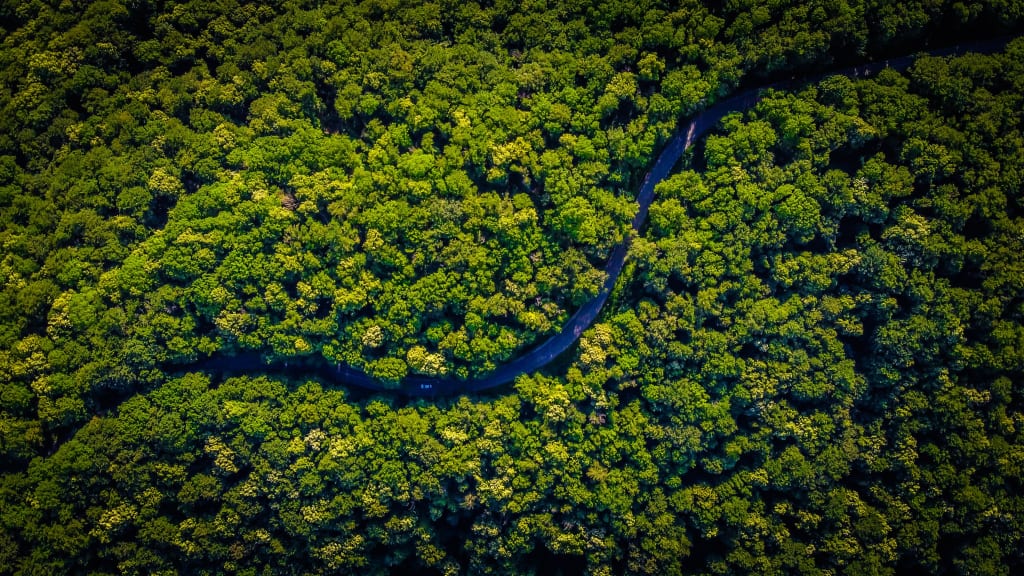
As technology and infrastructure improve, the world seems to be getting smaller. The ability to travel the world is becoming accessible to more and more people as the cost of getting to another country is getting cheaper.
It’s no wonder that the travel industry is the second-fastest growing industry in the world . Looking at internet searches will give you a good idea of how much travel is growing. During the final quarter of 2022, 35% of all searches were for travel in 2023 . That’s a 55% increase from 2021 !
And I can only see it continuing to grow , as long as another pandemic doesn’t come our way!
Traveling is great, and the more people get to see different parts of the world, hopefully, the more tolerant and educated we become . But there are downsides to more travel, one of them being the impact that it has on the environment.
According to the World Travel & Tourism Council, 8-10% of global CO2 emissions are caused by the travel and tourism sector, with the majority of these emissions being created by the travel to the destination. And sadly, these numbers will only get bigger as more people begin to travel unless we consciously do something about it .
That’s where green travel comes in.
What is green travel?
Green travel has many different names — sustainable travel, ecotourism, conscious travel — but all of them essentially mean the same thing or at least follow the same narrative.
Green travel focuses on minimizing the impact on the local environment and communities. It’s about choosing ways to travel that are sustainable and environmentally friendly. Whether it’s reducing or offsetting your carbon emissions, reducing waste, staying in eco-friendly accommodations, or shopping locally and supporting communities.
There are plenty of ways to travel in a green way, and that’s what we’re going to be exploring in this article.
Watch out for greenwashing
This needs to be covered pretty early on as you don’t want to try your best to travel sustainably and then realize that you’ve actually been greenwashed.
What is greenwashing?
Greenwashing is when a company tries to appear to be environmentally friendly and claims that its practices are sustainable, when in fact this isn’t true. They may try to emphasize sustainable aspects of their company to overshadow their bad practices that are having a devastating effect on the environment.
Demand for environmentally friendly products and operations is growing as more people want to do their part in looking after our planet. A lot of companies have seen this as an opportunity to boost their profits and attract new customers by advertising that they’re operating in an environmentally friendly way.
Examples of greenwashing
A quick Google search will reveal plenty of examples of greenwashing from brands that we interact with on a daily basis. Here are two well-known companies that thought they’d give greenwashing a go:
In 2020, Ryanair announced that they were Europe’s ‘lowest emissions airline’. I’m not sure how they reached this conclusion, but the Advertising Standards Authority certainly didn’t agree with this claim and quickly banned all of the ads promoting this.
McDonald’s is guilty too. In 2019, they introduced paper straws. Round of applause for Mcdonald's, right? No. Although they were trying to address the problem of plastic pollution, they just shifted the problem instead. The paper straws weren’t recyclable, and more trees were having to be cut down to make them!
How to spot greenwashing?
In an ideal world, we shouldn’t have to keep an eye out for greenwashing. Companies would be honest and actually try to look after our planet. Unfortunately, that’s not the world that we live in.
And greenwashing isn’t always easy to see. You often have to go out of your way to do your own research to verify the company's claims. You’ll have to look at third-party research and reports, and check the fine print of the company.
All we can do is try our best, and hopefully, the huge corporations start to adopt this attitude too.
How to travel sustainably: eco-friendly vacations
At times, trying to save our planet can feel hopeless. We often hear people saying "But I’m only one person. My actions aren’t going to make a difference". If everyone adopts this way of thinking then of course nothing is going to change!
If everyone starts to act more sustainably, especially when it comes to travel, then as a collective it will make a difference.
And green travel is easier than you think . There are plenty of ways and changes that you can make to your travels that can make them more sustainable:
Slow travel
Traveling slowly has so many benefits , but is often tossed to the side as travelers want to tick off as many places as possible. Whilst this is tempting, you end up only touching the surface of that country, missing out on truly learning about the culture and people of that place.
When I travel slowly, my connections with places and people are so much deeper and more memorable. Try it, and I’m sure you’ll prefer it to being in a new place every few days .
Taking your time will also save you money . You can often negotiate better deals on accommodation if you’re staying for longer. You’re not constantly splashing the cash on transportation and you’ll probably cook more rather than eat out.
It’s also better for the environment . Instead of hopping on a flight every two weeks, you’ll be in the same place for longer.
Stay close to home
This is potentially one of the harder changes to make as the urge to see the world is so strong within many of us.
But staying close to home isn’t as bad as it sounds. Every country has something spectacular to offer , we just often overlook them if they’re in our own country. New and foreign things always seem more exciting, but take some time to look at things to do in your own country.
As I mentioned before, most of the carbon emissions from travel come from getting to the destination itself . By staying in your own country you’re removing this negative impact on the environment. If you live in Europe, maybe you can visit some of your neighboring countries and get there by train.
As well as being a more sustainable way to travel, it can save you money too. Your transportation costs will be significantly lower. No visas to think about either.
Choose sustainable destinations

Some countries are doing more than others to make themselves a sustainable destination to visit.
For example, Bhutan is one of the best ecotourism destinations in the world . Since 1991, Bhutan has been charging visitors a daily Sustainable Development Fee. The money is used on projects such as offsetting Bhutan’s carbon footprint from tourism, supporting community education, organic farming, and upskilling workers in the tourism industry.
The tourism fee is pretty expensive, at $200/day, but there’s a price to pay if we want to protect our planet.
A more affordable ecotourism destination is Slovenia which has made it easier for you to choose sustainable options. If an accommodation or tourism service has a Slovenia Green Label, you know that you’re helping to preserve local traditions and protect the environment.
It’s important to research a destination beforehand to see what they're doing to be more sustainable and protect their environment.
Continue reading about ecotourism and the top 10 ecotourism destinations .
Choose a place that will benefit from your visit

Some countries really don’t need any more visitors. A growing number of countries are now struggling with overtourism — when too many people visit the same destination, often leaving a negative impact on the environment and local communities.
You can probably already name a few places off the top of your head after seeing pictures of huge crowds fighting to witness the same tourist attraction. Some well-known examples include Rome, Bali, Barcelona, and the Yucatan peninsula in Mexico.
Sure, there’s a reason why everyone wants to visit these places. They’re incredible and popular for a reason. But there are plenty of other lesser-known spots that you could visit instead.
Want to learn more about overtourism? Here’s what it is and how you can avoid it .
Think about what you pack
Green travel starts before you even pack your bags to leave . What you bring with you in your backpack will have an impact on the place that you’re visiting.
The first sustainable swap that everyone should be making is to reef-safe suncream . These suncreams don't contain chemicals that harm the coral and reef when you go swimming in the sea. Hawaiian tropics has a great reef-safe suncream that I highly recommend.
Another easy action is to travel with a reusable water bottle . In some countries you'll be able to drink tap water and can directly fill up your water bottle, avoiding having to buy bottles of water.
Bring a tote bag to take with you whenever you go shopping so that you don’t have to take a plastic bag. Or if you don’t have another bag, get a plastic bag one time and keep on reusing it.
Our coastlines are being ruined by plastic, so try to avoid using and buying it wherever you can.
This minimalist packing list should help you to pack sustainably the next time you travel.
Choose green accommodation
According to research carried out by Booking.com, 78% of travellers say they intend to stay in a more sustainable property in the coming ye a r – yet 29% don’t know how to find sustainable travel options.
With some accommodations, it’s clear to see that they’re operating in an eco-friendly way. They may have solar panels, reuse their water, employ local people and buy from the local community. With others, it may not be as obvious, or it could just be greenwashing.
Spend some time looking at the accommodation's website, and you could even message them if you have any questions about their sustainable practices.
Booking.com have also made it easier to find sustainable accommodation by introducing its ‘Travel Sustainable’ badge. It’s an independently validated recognition program that now appears as a small icon on sustainable places to stay. They do all the work for you so it’s easier to make green decisions.
Booking is offering 2% of Cashback to backpackers who create a profile on Worldpackers . Subscribing to Worldpackers is free, and you only need to subscribe to a plan when you decide to have your first experience through the platform. If you choose the Pack Plan, you will guarantee 4% of Cashback on Booking.com , in addition to other advantages.
*The Cashback benefit is limited to $200 per booking, and you must log in to your Booking.com account to gain access to Cashback.
Choose sustainable modes of transportation

This is often the first swap that people make to travel more sustainably. Instead of taking flights, which produce a lot of CO2, try to take public transport.
Sometimes taking a flight doesn’t even work out that much quicker, and it’s normally a lot more expensive. By the time you account for the time it takes to get to the airport and the wait time, it can sometimes take just as long as taking a bus or a train.
You can also decide to visit countries that are in the same area to avoid taking flights. For example, you could travel all the way from the USA to Argentina without having to take a flight. There are buses, boats and trains that can take you across the borders. Same with Europe and Southeast Asia.
Again, this is also a much cheaper way to travel than flying to the other side of the world to visit your next country.
Eat, stay, and shop locally
Make the conscious decision to stay in local homestays, eat at local restaurants and buy from shops that are run by people in the community.
Sometimes it might be easier to eat at a chain restaurant or stay at a well-known hotel, but this often means that the local economy isn’t benefiting from your money as much. Instead, it’s making rich people richer.
It’s better for the local economy, but it is also likely to be better for you. If you’re visiting a foreign country, it’s likely that you want to immerse yourself in the local culture as much as possible. Staying, eating, and buying locally is often the best way to do this. Plus, the local restaurants are more often than not the best places to eat!
If you’re a solo traveler, check out these 12 tips for responsible travel .
Give back by volunteering
Green travel isn’t just about reducing things, it can also be about giving back and leaving a positive impact on the communities that you’re visiting.
One way to do this is by volunteering . You can contribute your skills and donate your time to people that will benefit from it.
Volunteering also allows you to spend more time in a place, immersing yourself and really getting to know the culture. There are so many benefits of this, one of them being that you become a better-educated individual who will also be able to teach others about different cultures and ways of living.
Here’s how you can be an environmental volunteer .
How to find volunteering opportunities?
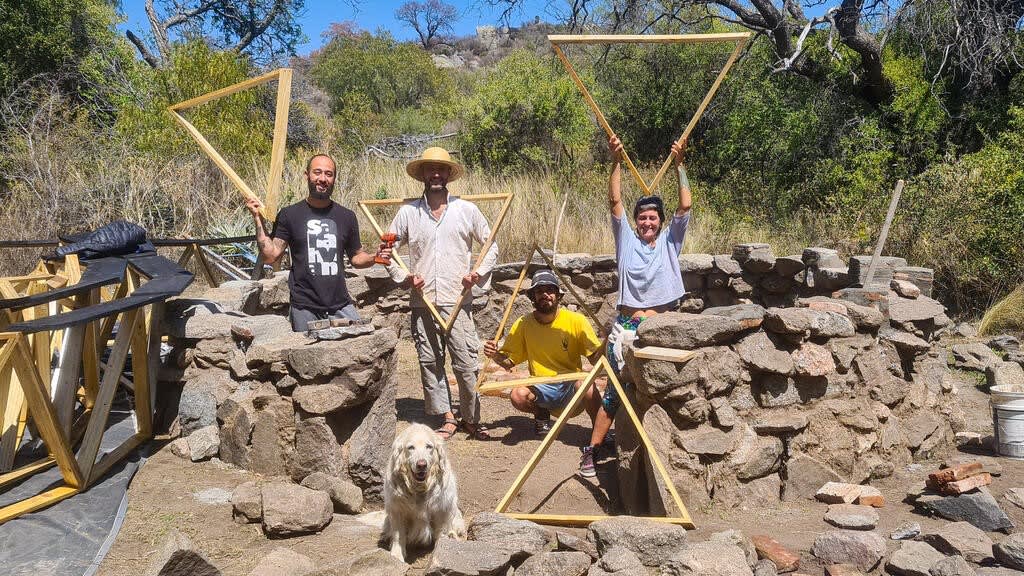
Worldpackers is a fantastic place to find volunteering opportunities that have a positive environmental and social impact. You can use their filters to find exactly what kind of sustainable volunteering you’re looking for .
You can filter by ‘eco programs’ which will show you places where you can learn permaculture, farming, or contribute to an ecovillage.
If people are more your thing, use the 'social impact' filter. This will show you volunteer opportunities in NGOs, schools, and social projects.
Here are some examples of sustainable volunteering opportunities to spark your imagination:
- Teach languages in Uganda
- Work with kids to help them understand animal care in Cape Verde
- Lend a helping hand on a farm in Brazil
- Contribute your handyman skills in the US
- Help this animal shelter in Tenerife
Check out plenty more environmental volunteer opportunities on Worldpackers.
The first step of green travel is being aware of what it is and why we should be trying to travel more sustainably . The second step is changing our mindsets and consciously making decisions that have less of an impact on the environment.
Traveling isn’t going to slow down anytime soon, so we need to make sure we find a way to do it in a way that isn’t going to destroy our planet . And that needs to start right now!
Want to learn more about planning your trip? By subscribing to the WP pack pla n you have unlimited access to +120 courses at Worldpackers Academy, the travel school made by travelers!
Join the community!
Create a free Worldpackers account to discover volunteer experiences perfect for you and get access to exclusive travel discounts!
Kate Woodley
Maskedtravelsx
Kate is a Management Consultant (and now writer) who decided to take a 2 year career break and travel the world. She shares her travels around the world and shows people the fun of solo travelling!
Be part of the Worldpackers Community
Already have an account, are you a host, leave your comment here.
Write here your questions and greetings to the author
Apr 20, 2023
May 04, 2023
We all need to think twice about how we live and how we survive and how we travel, we are all responsible during our vacations in any country, therefore we support every sustainable travel available. Travel green in Morocco with https://moroccogreentours.com/
More about this topic

What is a conscious traveler and how can you become one?
Carbon neutral travel: how to reduce your carbon footprint.
How ecotourism benefits the environment and local communities
How do worldpackers trips work.
As a member, you can contact as many hosts and travel safely as many times as you want.
Choose your plan to travel with Worldpackers as many times as you like.
Complete your profile, watch the video lessons in the Academy, and earn certificates to stand out to hosts.
Apply to as many positions as you like, and get in contact with our verified hosts.
If a host thinks you’re a good fit for their position, they’ll pre-approve you.
Get your documents and tickets ready for your volunteer trip.
Confirm your trip to enjoy all of the safety of Worldpackers.
Have a transformative experience and make a positive impact on the world.
If anything doesn’t go as planned with a host, count on the WP Safeguard and our highly responsive support team!
After volunteering, you and your host exchange reviews.
With positive reviews, you’ll stand out to hosts and get even more benefits.
Watch: Drone video shows destructive tornado topple wind turbines near Greenfield, Iowa
As Greenfield, Iowa, assesses the town's damage, a wind farm near the area also took a hit from Tuesday's tornado and severe storm.
Drone video footage from Reed Timmer , a storm chaser and meteorologist, captured a tornado in Iowa snapping a wind turbine in half and causing damaging others. Timmer described the footage as showing an "up-close helical suction vortex action" tornado as it spanned the Iowa field.
Watch as an Iowa tornado destroys a wind turbine
The drone footage starts by showing the tornado run through a residence as it crosses an Iowa field. As it moves further, it creeps closer to the wind turbine farm instantly snapping one in half with its force. The upper half of the wind turbine falls to the ground as the tornado continues across the field for the seven-minute video.
How many wind turbines were damaged from Tuesday's tornado?
MidAmerican Energy and Vestas US say 10 wind turbines were destroyed in the storm that swept through Adair and Adams counties Tuesday. MidAmerican said a tornado struck five turbines its Orient wind farm and one in its Arbor Hill wind farm. Both are located in Adair County near Greenfield, which experienced widespread damage and fatalities from a tornado.
Vestas said four turbines were destroyed in Adams County.
MidAmerican believes tornadoes in Adair County “ directly struck our wind turbines,” based on review of several social media posts, Tina Hoffman, a MidAmerican spokeswoman, said in an email.
MidAmerican turbines registered windspeeds over 100 miles an hour as the tornadoes approached, and the utility lost contact with its sensors, Hoffman said.
The company, owned by Warren Buffett’s Berkshire Hathaway, said the no technicians at the sites were injured, sheltering "in place at our operation and maintenance facilities," all of which are all equipped with storm shelters, Hoffman said.
No one was injured by the toppled wind turbines, either, she said.
“This was an unprecedented impact on our wind fleet, and we have operated wind farms since 2004,” she said. “We have experienced only one other instance of a wind turbine collapse, which was also caused by a tornado.”
She said manufacturers design wind turbines to withstand Iowa's changing weather conditions, including severe thunderstorms and high wind events. “As we've seen from the damage sustained throughout several Iowa counties, few structures can withstand a direct hit by a powerful tornado such as what we experienced on Tuesday,” she said.
MidAmerican said it’s inspecting all its wind operations in the area “out of an abundance of caution,” before resuming operations.
What does 'helical suction vortex' mean?
Helical more broadly describes a spiral, according to Merriam-Webster's Dictionary . Suction vortex means a small but intense vortex within a tornado's circulation, according to the National Weather Service . Extreme damage from violent tornadoes is often attributed to the suction vortices.
How tall was the wind turbine struck by a tornado in Iowa?
It's not known exactly what type of wind turbines were hit by a tornado in Iowa. Most turbines owned by MidAmerican are less than 150 meters tall.
The majority of turbines in the area are Vestas V-120 models, which usually stand around 90 meters tall. The rotors are 120 meters in diameter and they are typically made from a carbon fiber reinforced by epoxy and glass fiber, according to Vestas . The full installation can weigh over 400 tons and the rotors alone can weigh as much as 65 tons, according to Vestas .
Others are models are similar in size and dimensions.
Where are the wind turbines that were hit by a tornado in Iowa?
The tornados in Timmer's video were somewhere near Greenfield, according to his YouTube caption on the video. While damage did occur in Adair County, there was no significant damage to any of MidAmerican's wind turbines in Adams County just south of Adair.
Kate Kealey is a general assignment reporter for the Register. Reach her at [email protected] or follow her on Twitter at @ Kkealey17 .

IMAGES
VIDEO
COMMENTS
Definition of Green Tourism. Green tourism, also referred to as sustainable tourism or eco-tourism, is a form of travel that focuses on minimizing the negative impact on the environment, supporting local communities, and preserving cultural heritage. It aims to create a balance between enjoying the beauty of natural and cultural attractions ...
For the United Nations Environment Programme, green tourism is a key component toward a sustainable economy, one that results in "improved human wellbeing and social equity, while significantly reducing environmental risks and ecological scarcities" (UNEP 2011: 16). As tourism patterns are increasingly influenced by sustainability ...
Abstract. Online sales and green investment are two important ways to improve the sustainability of the tourism supply chain under the pandemic. This research constructs an omni-channel tourism supply chain consists of two tourism service providers (i.e., TSPs) and one online travel agent (i.e., OTA).
The answer is a lot. This is because global tourism is really big business. According to the World Tourism Organization (UNWTO), tourist spending swelled from only $2 billion in 1950 to $1.2 trillion in 2015. The number of international tourists has grown by orders of magnitude as well, from 25 million travelled in 1950 to 1.2 billion in 2015.
The tourism industry should be encouraged to embrace 'clean green' tourism, which means that firms should do their best to decrease the environmental impacts of their operations. If a destination is to achieve sustainable tourism development then the actions of its constituent firms must be consistent with and support this objective.
The concept of green tourism has evolved over time and is presently used with different meanings. The original one, spread during the 1980s, stands for small-scale tourism which involves visiting natural areas while minimizing environmental impacts. In this line, green tourism has been used interchangeably with such concepts as ecotourism ...
Keywords: green travel, green transition, tourism economy, green action, planet, people, prosperity, biodiversity, nature conservation, climate action, circular economy, governance, tourism policy, finance, public health, social inclusion, community integration, SDG 6 Clean water and sanitation, SDG 7 Affordable and clean energy, SDG 8 Decent ...
Green tourism, also known as sustainable tourism, has become an increasingly popular way to travel. It aims to minimize the negative impacts of traditional tourism on communities and the environment. With more travelers looking for eco-friendly lodging, transportation and activities, green tourism offers a way to explore new places while also ...
Tourism is one of the world's fastest growing industries and an important source of foreign exchange and employment, while being closely linked to the social, economic, and environmental well-being of many countries, especially developing countries. Maritime or ocean-related tourism, as well as coastal tourism, are for example vital sectors of the economy in small island developing States ...
A tourism distribution channel is a network of intermediaries through which a traveler purchases a good or service. This system is a complex, global network of independent businesses that link people with tourism providers. It is especially important for international travel. Different combinations of intermediaries result in a wide range of ...
Firstly, green tourism supports local communities. Particularly, responsible tourism generates greater economic benefits for local people and enhances the well-being of host communities, improves working conditions and access to the industry. Secondly, sustainable tourism has a lower ecological impact. On the one hand, part of green tourism is ...
Green tourism History of green tourism. The term green tourism emerged in the 1980s referring to small groups of tourists visiting natural areas. They had the minimum impact on the environment. Eventually, people used it interchangeably with ecotourism and sustainable tourism.
Green tourism, a form of ecotourism, is low-impact tourism with an eye toward protecting the environment and culture of an area. The United Nations has set up certain criteria for ecotourism, but green tourism can cover a wide range of standards and conditions, from fully compliant to less stressful on the environment than standard tourism. ...
The Tourism Background Report is an extended version of the Tourism Chapter of the "Green Economy Report" (GER), which makes the case for investments in greener and sustainable tourism as a means to create jobs and reduce poverty while also improving environmental outcomes. The Report analyzes the main variables that influence tourism ...
Green tourism usually involves things like visiting natural, untouched areas in responsible, non-damaging ways, getting to your destination with as little greenhouse gas emissions as possible, and avoiding tourist attractions that are harmful to nature or to society. Another aim of eco-friendly tourism is to support the local community in the ...
Sustainable tourism and ecotourism are similar concepts and share many of the same principles, but sustainable tourism is broader; it covers all types of travel and destinations, from luxury to backpacking and bustling cities to remote rainforests. Create a world where people and the planet prosper together.
The awards certification programme we run recognises the commitment of tourism businesses which are actively working to become more sustainable. Our Bronze/Silver/Gold awards are acknowledged worldwide as an indicator of good environmentally-friendly practice, and are a great way of progressing on a green journey as well as acting as a hallmark ...
Elaborating a channel design process constitutes the last phase in a major 5-year project aimed at developing a more systema- tic understanding of the diverse distribution channels for New Zealand tourism and examining ways of increasing their effective- ness (Pearce, 2003). The final objective of the project was to develop a set of best ...
The chain of distribution in tourism refers to the businesses and platforms involved in selling, distributing, and bundling tourism products. This process begins with the primary tour and activity provider all the way to the end consumers experiencing it. Generally, there are four steps to the distribution chain: 1. Suppliers/principals.
Green Tourism. From its beginning, green tourism was known as a small scale tourism that encouraged people to visit natural areas and minimize the impacts of tourism on the environment. The term is used for businesses with an environmentally friendly activity. However, more and more lately, green tourism has been oftentimes used by businesses ...
The issue of channel design has been virtually ignored in the tourism distribution literature. This article seeks to contribute to filling this gap by developing a practical step‐by‐step process to preparing an effective tourism distribution strategy. It is based on a review of the channel design literature and consideration of the ...
A tourism distribution channel is a network of intermediaries that facilitates the sales and delivery of products and services specifically related to tourism from suppliers to consumers (Buhalis and Laws 2001; Kracht and Wang 2010; Longhi 2009).Tourism distribution channels can be distinguished from the ones of tangible goods in that goods are conveyed to consumers whereas tourists, in most ...
Check out plenty more environmental volunteer opportunities on Worldpackers. The first step of green travel is being aware of what it is and why we should be trying to travel more sustainably. The second step is changing our mindsets and consciously making decisions that have less of an impact on the environment.
As Greenfield, Iowa, assesses the town's damage, a wind farm near the area also took a hit from Tuesday's tornado and severe storm. Drone video footage from Reed Timmer, a storm chaser and ...